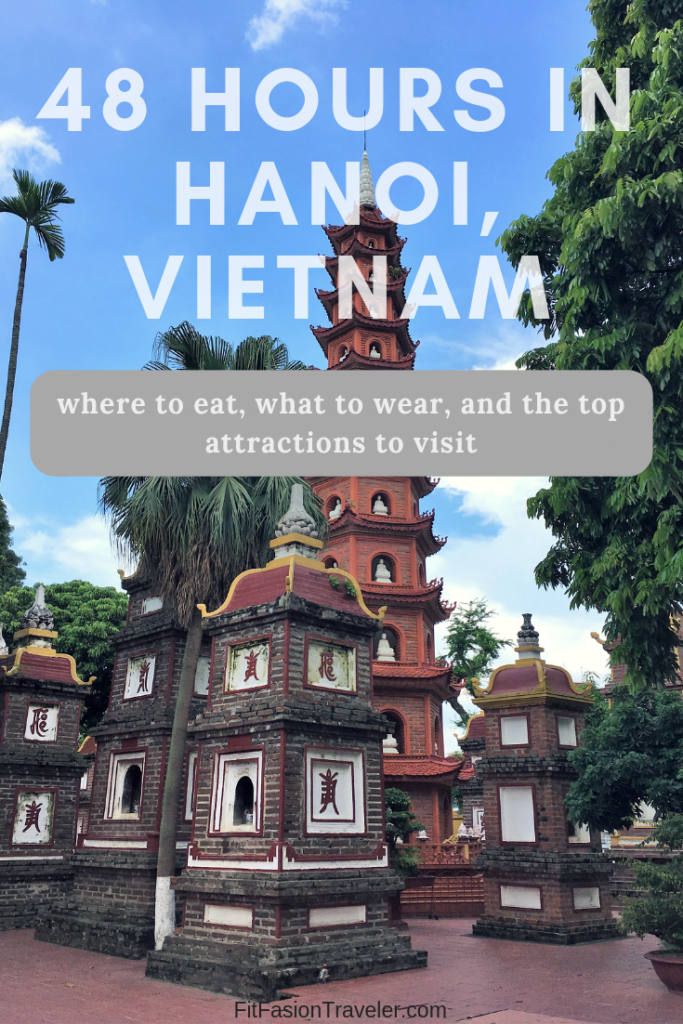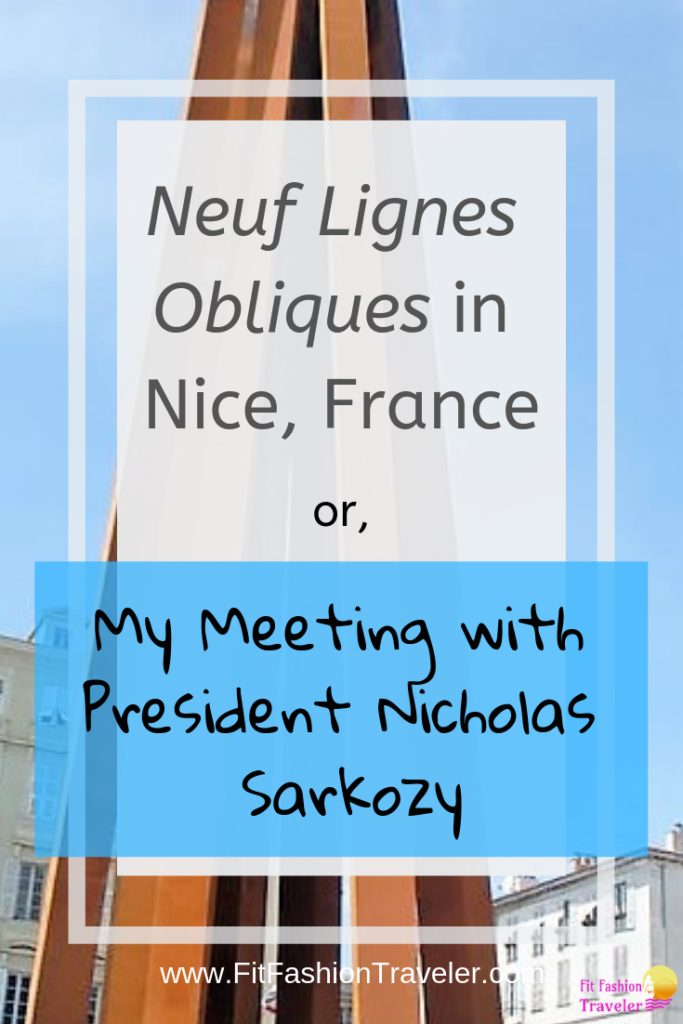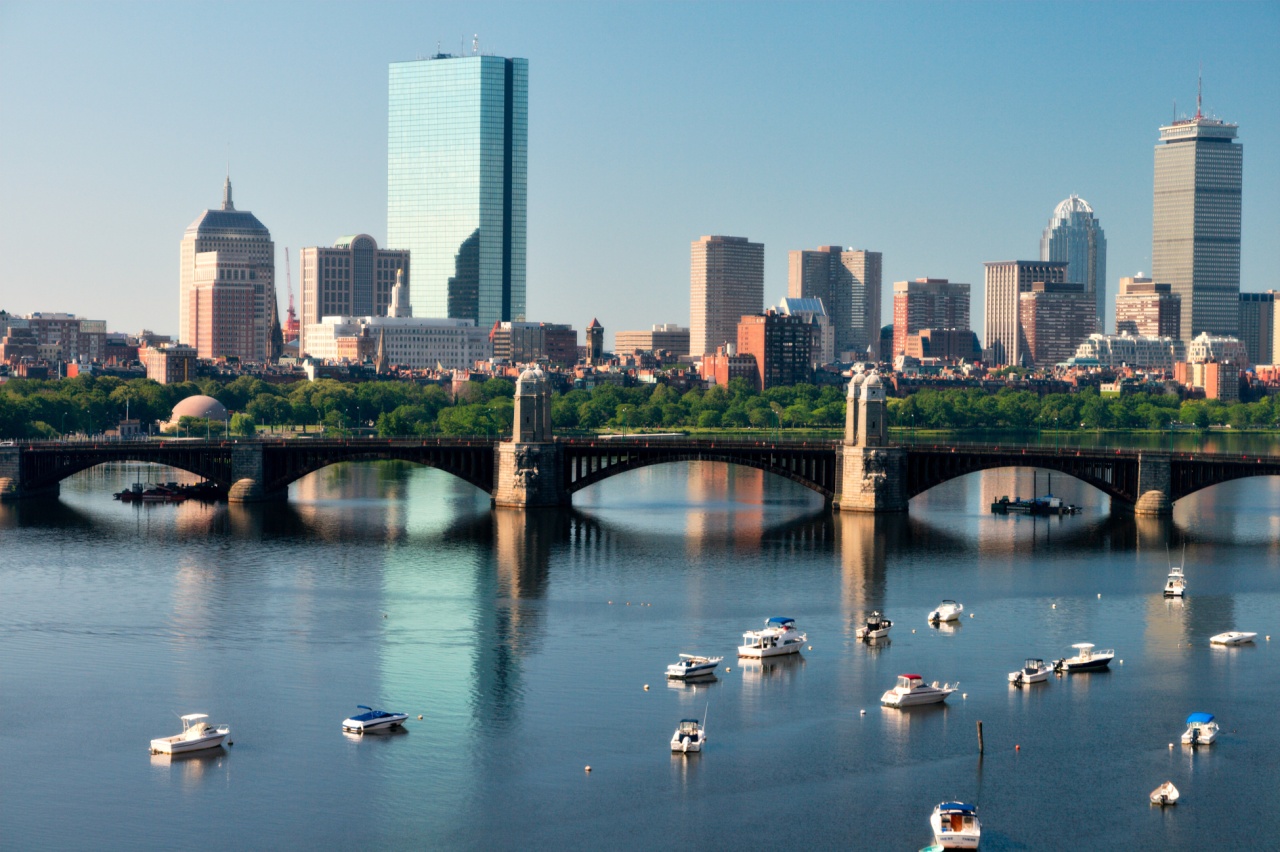
by Kelly | Mar 16, 2017 | Boston, Massachusetts, North America, Travel, Travel Advice, United States
So you want to visit Boston!
I have lived in Boston for about 10 years, first as a student and now as a young professional, and I am so excited to share what I know about the city over the next few posts. The first thing you need to do is get here: Boston is easily accessible by car, plane, train, and bus.
Driving to Boston
Boston is on the far Eastern coast of the United States. If you’re going to drive here, you have a few major highways to pick from. Visitors from the West, you’re probably going to drive in on Route 90 aka the Mass Pike or the Pike. I use the Pike every time I go home to visit my family and in 10 years I have never had a great experience. The speed limit may be posted as your standard 65 m.p.h., but if you’re not going at least 70 in the middle lane you will have someone on your bumper almost immediately. Further, the left lane is not necessarily used for passing, but for drivers going over 80 m.p.h. I recommend spending as little time on the Pike as possible, though it is unfortunately the best way for most drivers to reach Boston.
The other major highways running through Boston are Routes 93 and 95, both running North to South. In fact, Route 95 runs the entire length of the U.S. East Coast from Maine to Florida! They are more manageable to drive on than the Pike , but be careful going South on 93 as it doesn’t continue down to Rhode Island or Cape Cod (aka “the Cape”) but instead loops back around to the city.
As in any major city, parking in Boston can be difficult to find and expensive. If you are able to find a metered spot, I recommend using the “Park Boston” app to pay for your meter. If you find yourself out longer than anticipated and your meter is about to run out, you can just re-load time using your smartphone instead of running back to your car. If you are heading for the North End, the best garage to use is Parcel 7 because most North End locations will validate your ticket, leaving you to pay just $1 for 2 hours or $2 for 3 hours, which is unheard of in Boston. Most hotels will have parking garages available for you to leave your car, but likely at a steep price. Many people will opt instead to leave their cars outside the city at a T-station and take the T (the metro system) into the city instead.
Flying to Boston
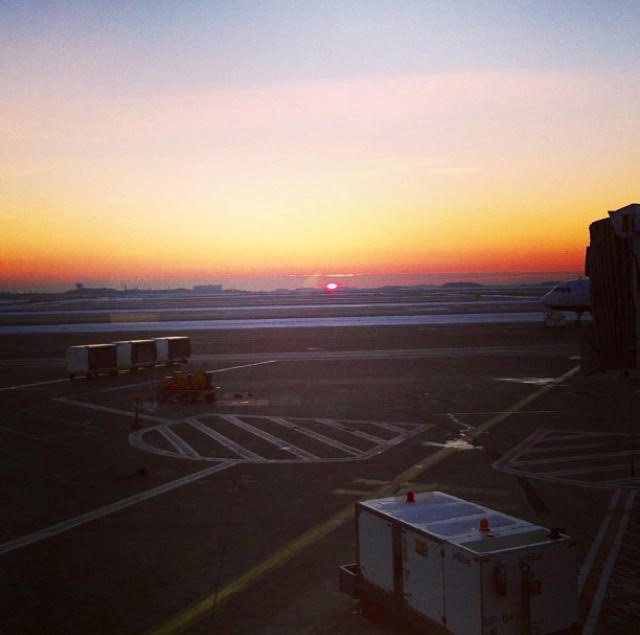
Sunrise over Boston Harbor from the window of Boston’s Logan Airport
Boston has its own airport pretty close to the city, Boston Logan Airport (BOS). This is the best airport to use to get to Boston, and it is serviced by 40 different airlines flying to and from 35 different countries and territories as well as most of the U.S. Other regional airports include Manchester, New Hampshire, and Providence, Rhode Island, but they are smaller, about an hour away, and will require you to rent a car or take a bus or train into the city.
Once you arrive at Logan Airport, you can catch a taxi at the taxi stand. The ride to city center will be about 15-20 minutes depending on traffic and cost about $35 plus tip. You can also rent a car, though as a local I have never had that experience so unfortunately cannot offer any information on doing so.
Your other option to get into the city is to take our metro system, known as the T! I highly recommend taking the Silver Line (which is actually a bus) to South Station, and then connecting to the rest of the T system from there. This is probably the quickest and most direct way to get to the city, and will take about 20 minutes. The other T line accessing the airport is the Blue Line: to use this line, you’ll need to catch the #88 shuttle bus at the airport, and then transfer at the aptly-named Airport T stop. Either way you choose, it will cost $2.75 per ride with a Charlie ticket, $12 for a 24-hour pass, or $21.25 for a 7-day pass. If you can find a Charlie Card at the airport, rides will be just $2.25 each.
Boston by Train or Bus
As with most cities, the most direct way to the city center is to arrive at the train station. Boston’s South Station is the main Boston station for Amtrak trains, though some trains also arrive at the North Station. The bus terminal is also located at South Station. Two types of trains roll into Boston each day, the Accela and the Northeast Regional. The Accela is more expensive, but travels faster and has less stops. Its interior is also more spacious and it usually has a dining car. The Northeast Regional is cheaper but stops multiple times along the Connecticut coast, in Rhode Island, and in southern Massachusetts coming from New York City (which could be ideal if you’re not originating in NYC).
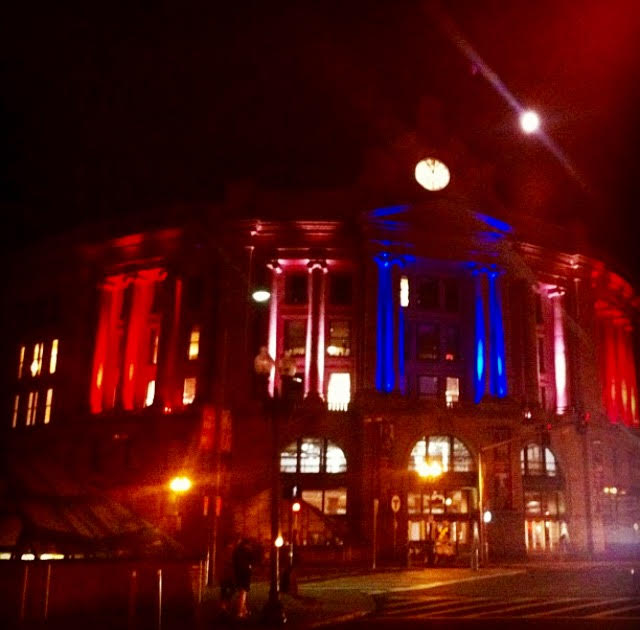
South Station by Night
You can take a bus to Boston from New York City, Springfield, MA, Rhode Island, New Hampshire, or Connecticut. Your bus line options run the gamut from the super-cheap Lucky Star and Mega Bus lines to the very common Peter Pan and Greyhound buses.
Both the Red and Silver lines of the T run through South Station, so as soon as you arrive you can easily get to your final destination! There is also a taxi stand available just outside where you can catch a cab.
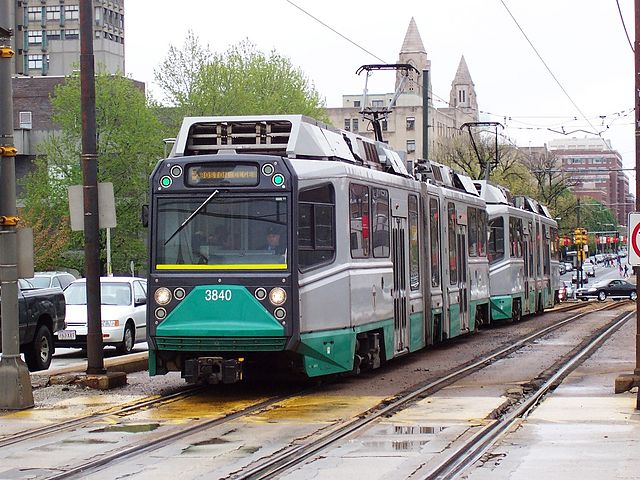
The T
Welcome to Boston! Now that you’re in the city, stay tuned for posts in the near future highlighting places to go and things to see.
Love this post? Save it on Pinterest for later!
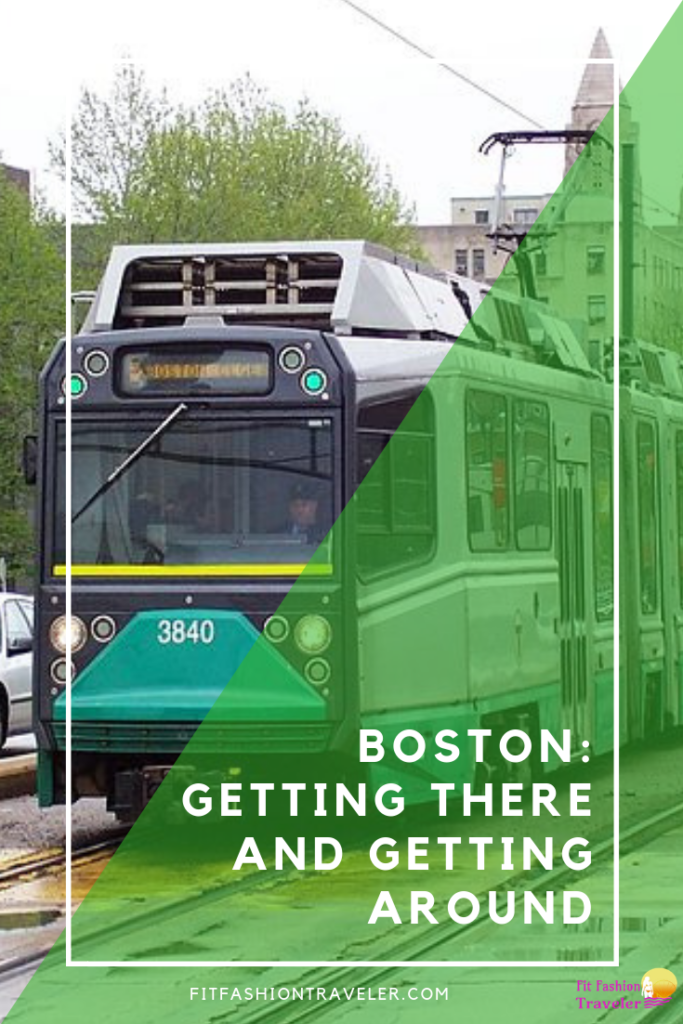
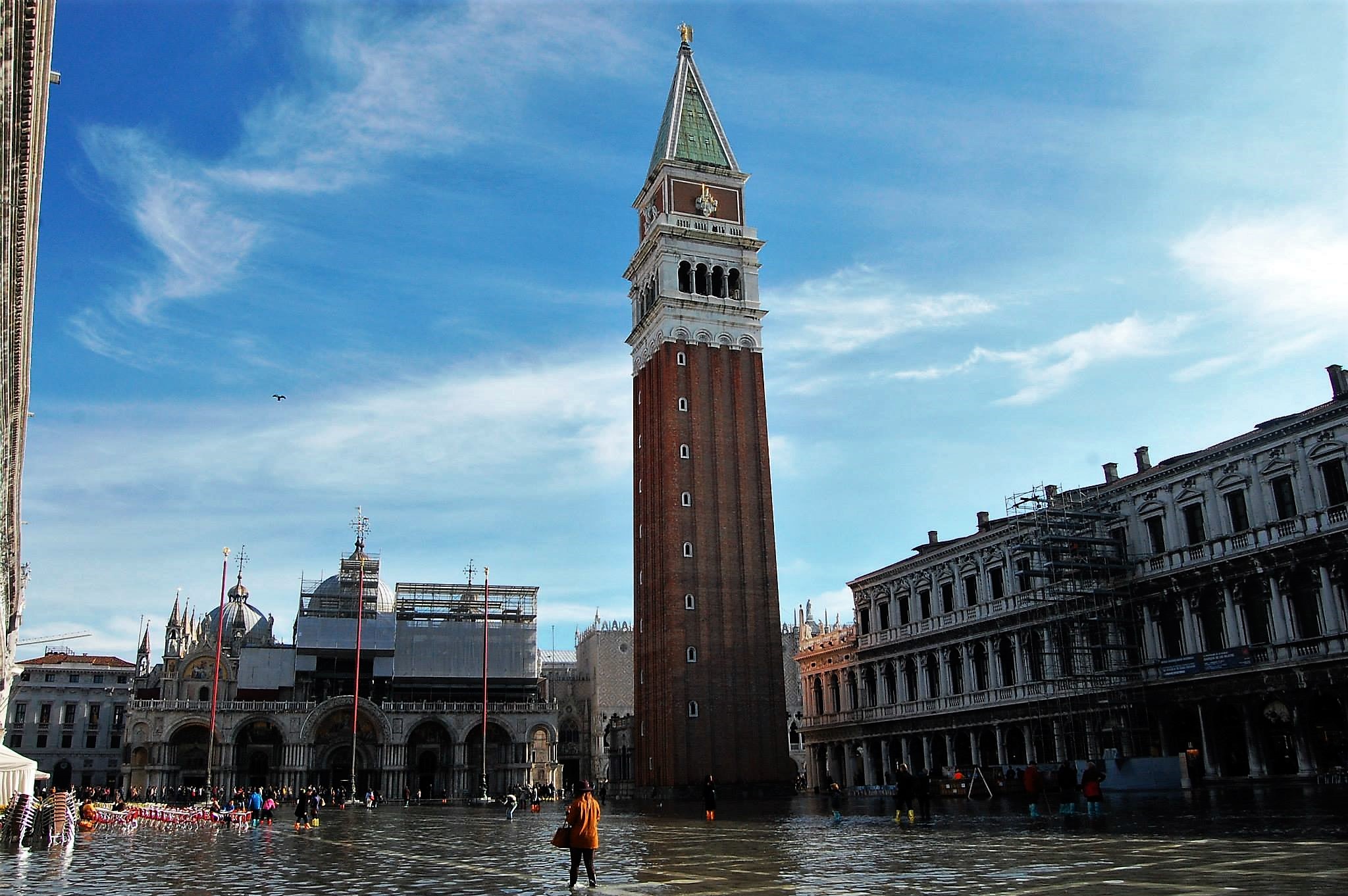
by Kelly | Oct 22, 2018 | Europe, Italy, Travel, Venice
A few years ago, I went to Venice during its acqua alta season. Some tourists travel to Venice specifically for the acqua alta. Others avoid Venice at this time. I did not know about it until my travel companion and I arrived during our European vacation. It was quite a unique experience, and one that I am glad I had the chance to see firsthand!
Looking for more crazy travel stories? Check out this one about The Time I Tried to Go to Nicaragua!
What is the Acqua Alta?
The official Venice CityPass website describes the acqua alta as “nothing more than a spike in the high tide affecting the city in the Fall and Winter”. The Adriatic Sea, to which the Venice Lagoon is connected, experiences daily tidal waters caused by the moon. These tides occur year-round. When they are accompanied by scirocco, strong winds crossing the Mediterranean that push water into the Lagoon where the city of Venice sits, the acqua alta occurs. An odd experience for visitors, the acqua alta has occurred in Venice every year for hundreds of years, so it is part of daily life for inhabitants.
Experiencing the Acqua Alta
When I lived in London, I had a week break “for studying” in early November. Seeing as final exams were not until mid-December, I instead decided to use this week for traveling. A friend from Boston came across the pond to travel with me for the week. We agreed to spend the first half of the week in Barcelona and the second half in Venice. Our timing was purely based on my schedule.
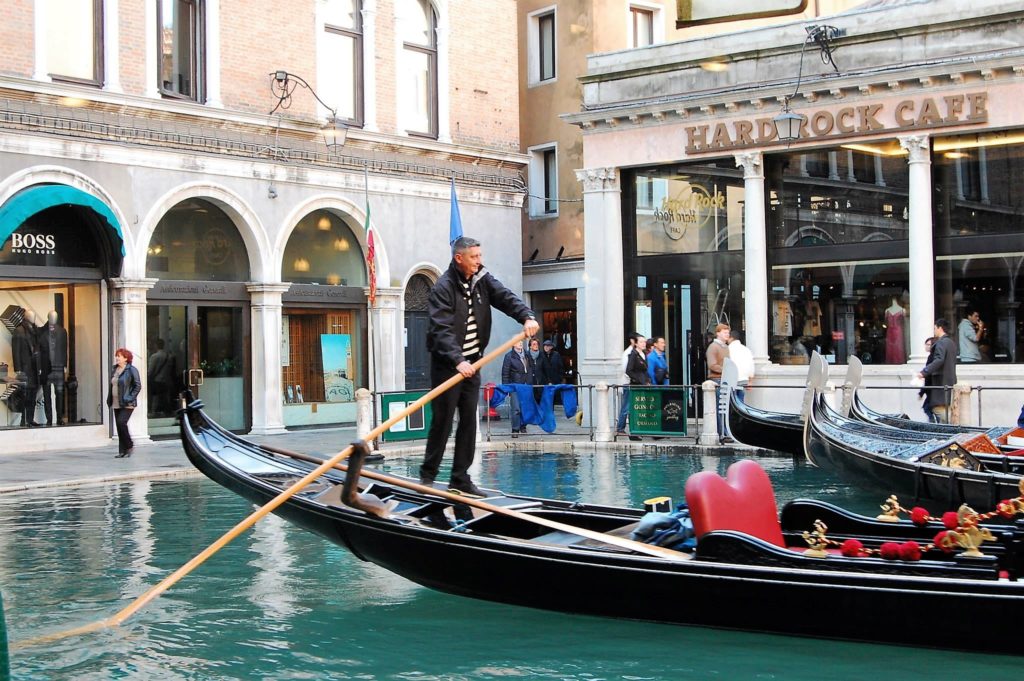
How we expected to find Venice: Gondola rides in the canals!
During our pre-vacation research we read about gondola rides, Aperol spritzes, the Piazza San Marco, Dodge’s Palace, and this phenomenon called acqua alta. I had heard rumors about Venice “sinking”, but thought it was sinking in the same way the Maldives are sinking: because ocean levels are rising very slowly, one day low-lying lands will be fully covered with water. However, the Maldives aren’t facing this fate until at least 2030. It is not an annual occurrence like the acqua alta.
Arrival in Venice: Dry Land
I was hopeful my friend and I would experience the acqua alta during our trip after reading about it. To my disappointment, the sidewalks and piazzas were bone dry when we arrived on a Thursday afternoon. This did give us time to spend the afternoon and evening wandering around Venice’s streets, exploring the city and trying to get lost among its many twists and turns. We headed for the Ponte Rialto, crossed the Grand Canal, enjoyed a glass of Italian wine at an outdoor cafe, stopped in a few shops selling murano glass souvenirs, and ended the night eating squid-ink pasta and drinking our first Aperol Spritzes. There are so many great things to do in Venice at night; I recommend checking them out before the water rises in the morning!

Ponte Rialto over the Grand Canal
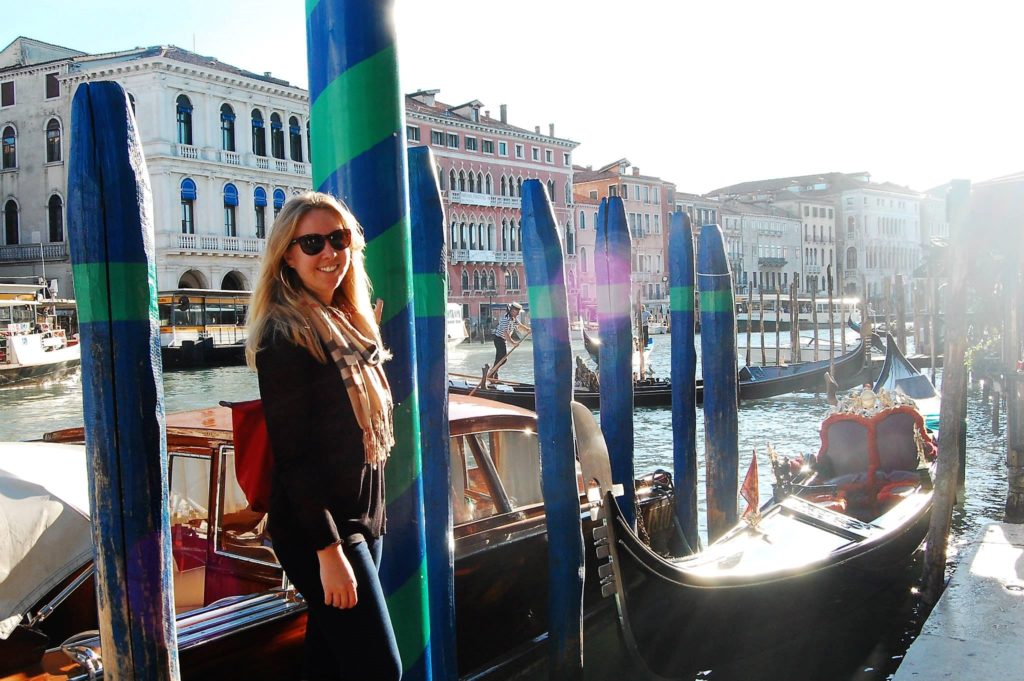
Strolling along the Grand Canal by the cafes and the gondola boats
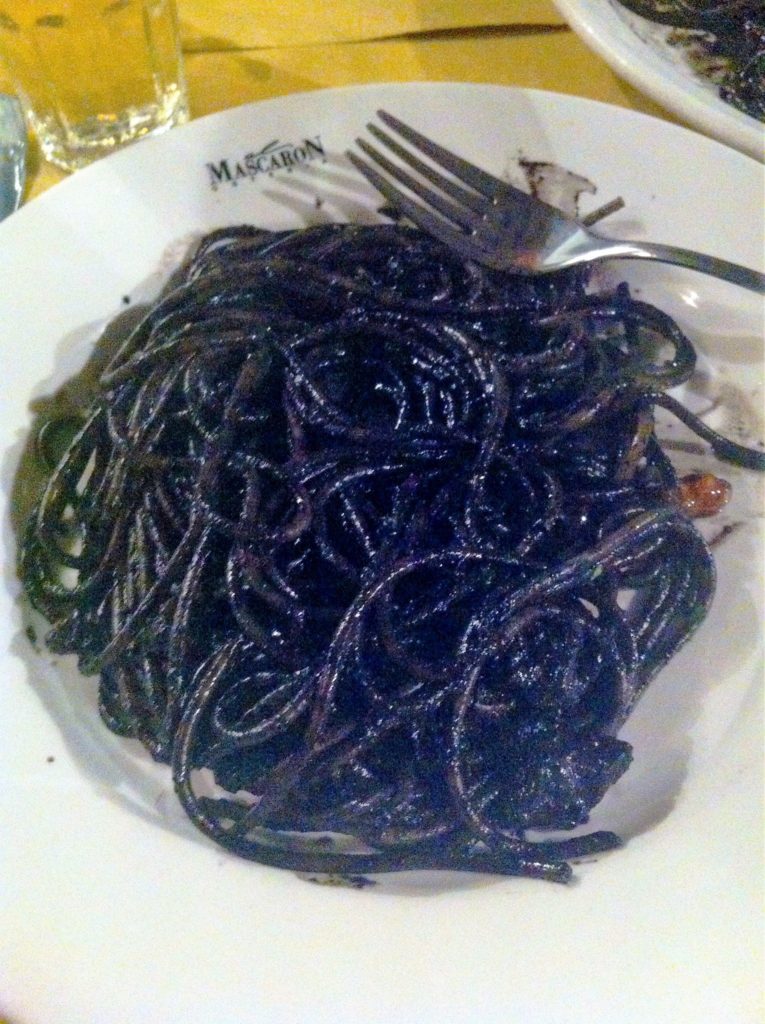
Squid Ink Pasta! I’ve since seen this available in the States, but Venice was my first experience with this interesting dish

Aperol Spritz, the signature Venetian apertif
Note: if you dislike Aperol, drinking it as a spritz does not make it better. My travel companion and I had met only a few months prior and were still trying to impress each other, so we spent all weekend drinking this “signature” Venetian drink that we both disliked. We only admitted this to each other months later!
Waking Up to the Acqua Alta
The Albergo Cavalletto & Doge Orseolo hotel in which my friend and I stayed was just outside of the Piazza San Marco. You can book this perfectly-located boutique hotel here*. Our first morning in Venice, I woke up and opened our window shades to look out at the square. I couldn’t believe what I was seeing. “Alex, you have to come look at this,” I said. There were fish swimming down the sidewalks on which we had walked just a few hours before! The acqua alta was upon us.
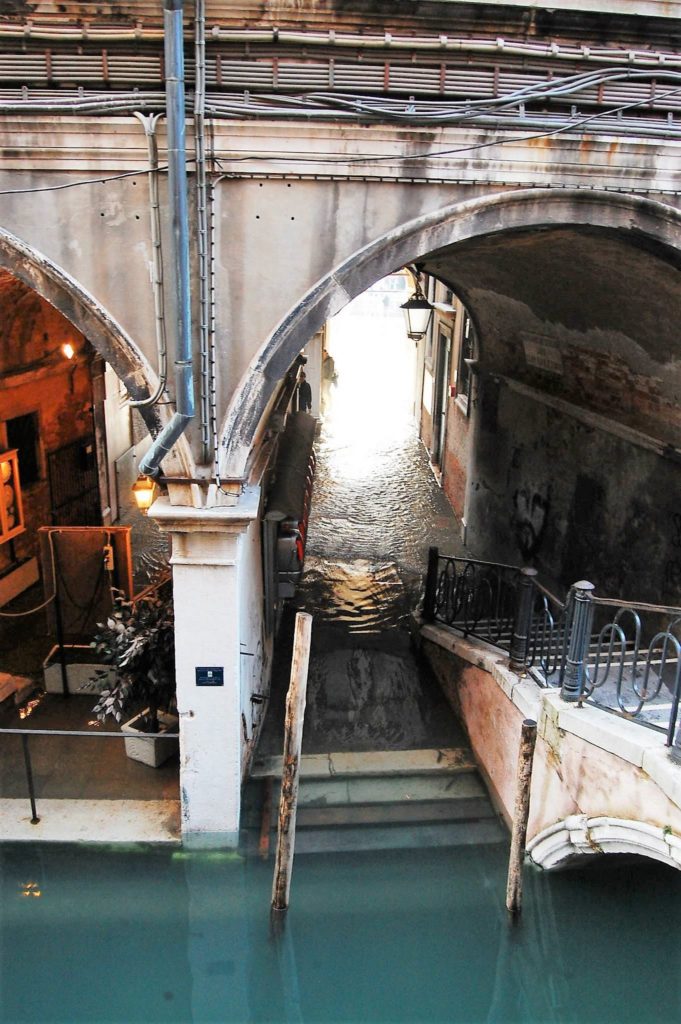
The steps leading from the sidewalk to our hotel’s front door: note the fish on the right side of the top two steps
This was not a slowly-occurring phenomenon, but one that appeared suddenly for a few hours almost every morning in the Fall and Winter! The first issue we dealt with was that our hotel was now surrounded by water a few inches deep. We needed to figure out how to still go out and enjoy the flooded city. Our shoes were not going to last for hours of wading. Luckily for us – and most tourists – the Venetians had found a solution to this. Every souvenir shop, including the one across the street from our hotel, sold “acqua alta boots,” or thin plastic knee-high covers that go over your shoes and pants and are secured by elastic bands. They are available for about 10 euro when you are in Venice, but you can also get yours ahead of time on Amazon here*.

“Super Sexy Acqua Alta Boots”
Wading Around Venice
The Venetians were clearly used to the acqua alta. They all had their acqua alta boots ready to slip over their very nice Italian shoes. They were content to go about their days as though there was not water all around them. The outdoor cafes were still open, and people were sitting around enjoying their morning coffees as birds and fish swam by their ankles. Those in charge of the San Marco Basilica had set up temporary platforms for tourists to wait on above the water outside the cathedral and in the foyer. And of course, the gondola rides continued as usual.
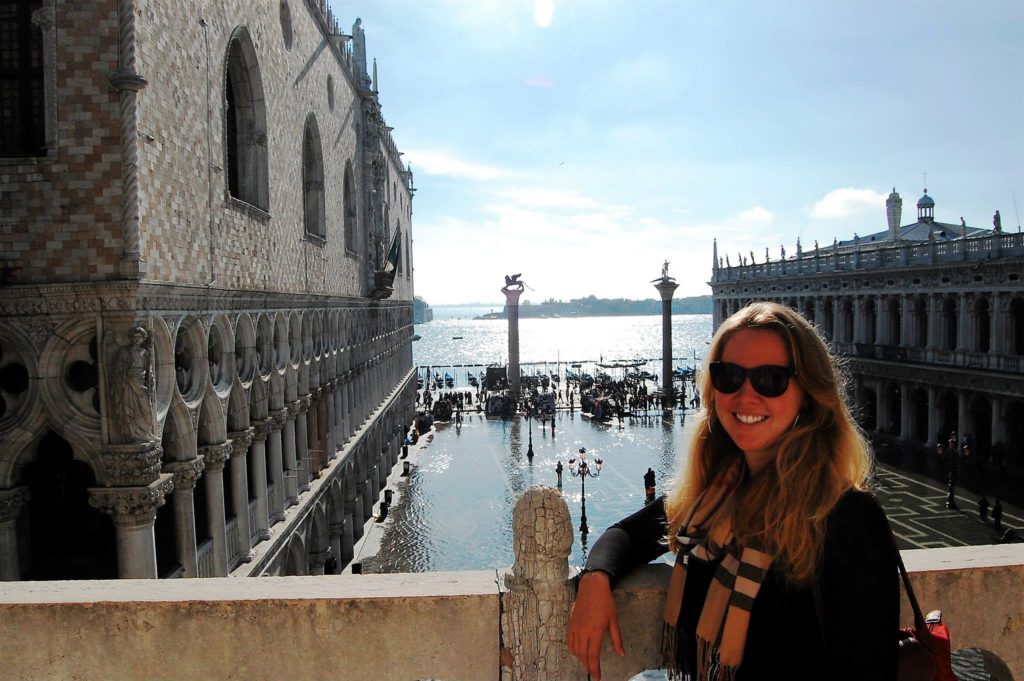
Flooding in front of the Dodge Palace, looking over the Lagoon
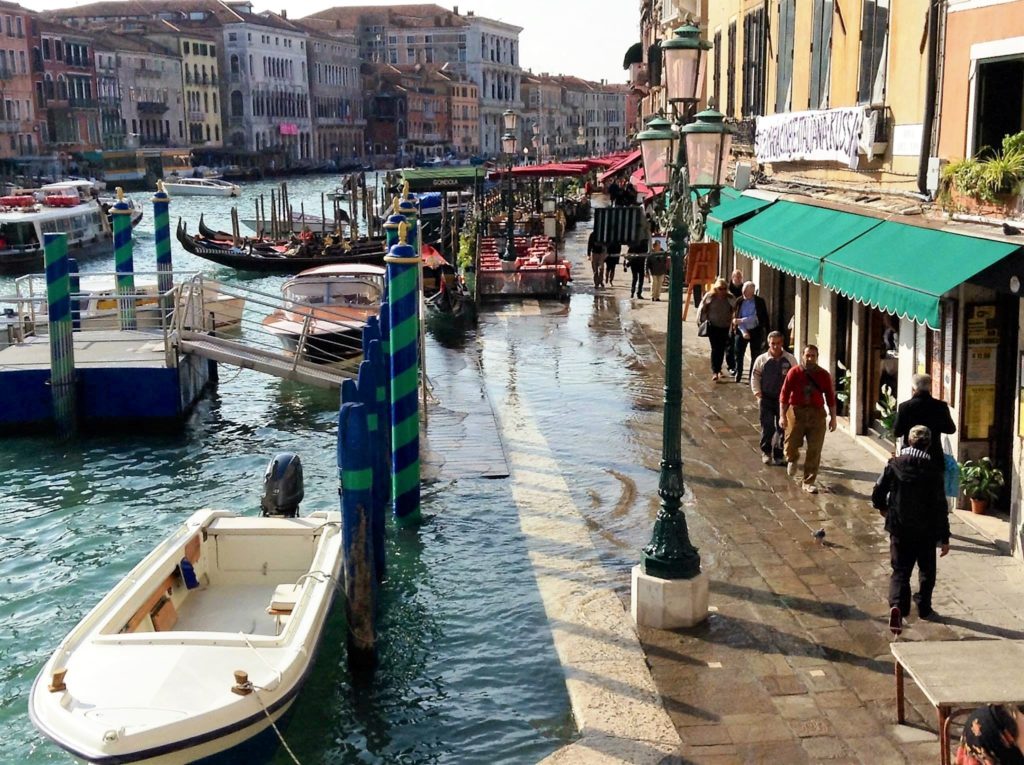
The same spot I had taken a picture by gondola boats the day before!
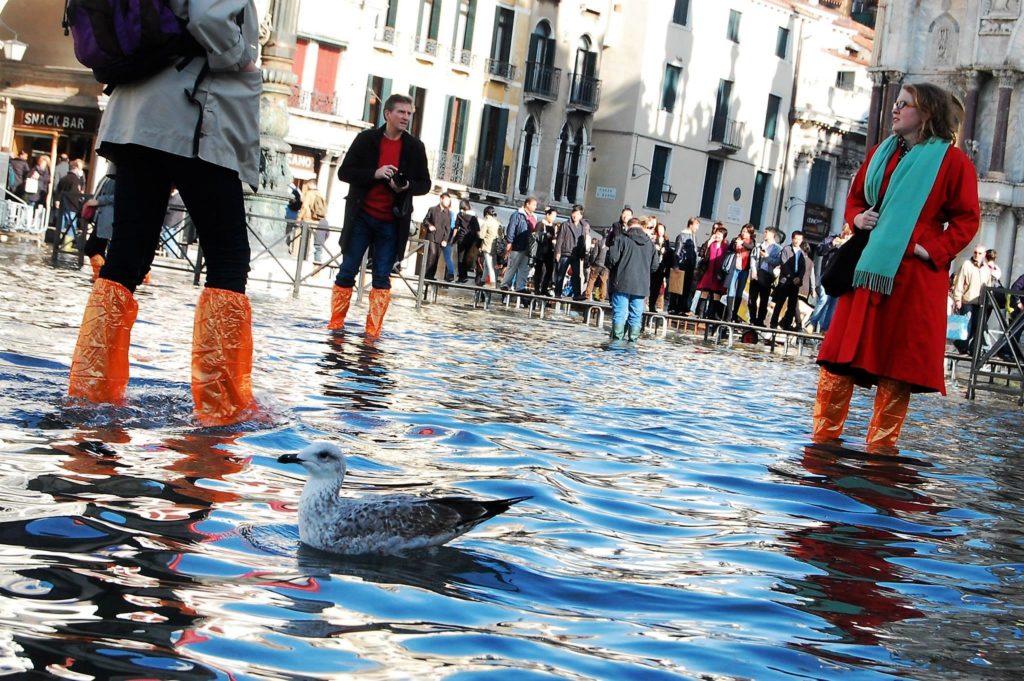
Birds enjoying their new pond in the Piazza San Marco
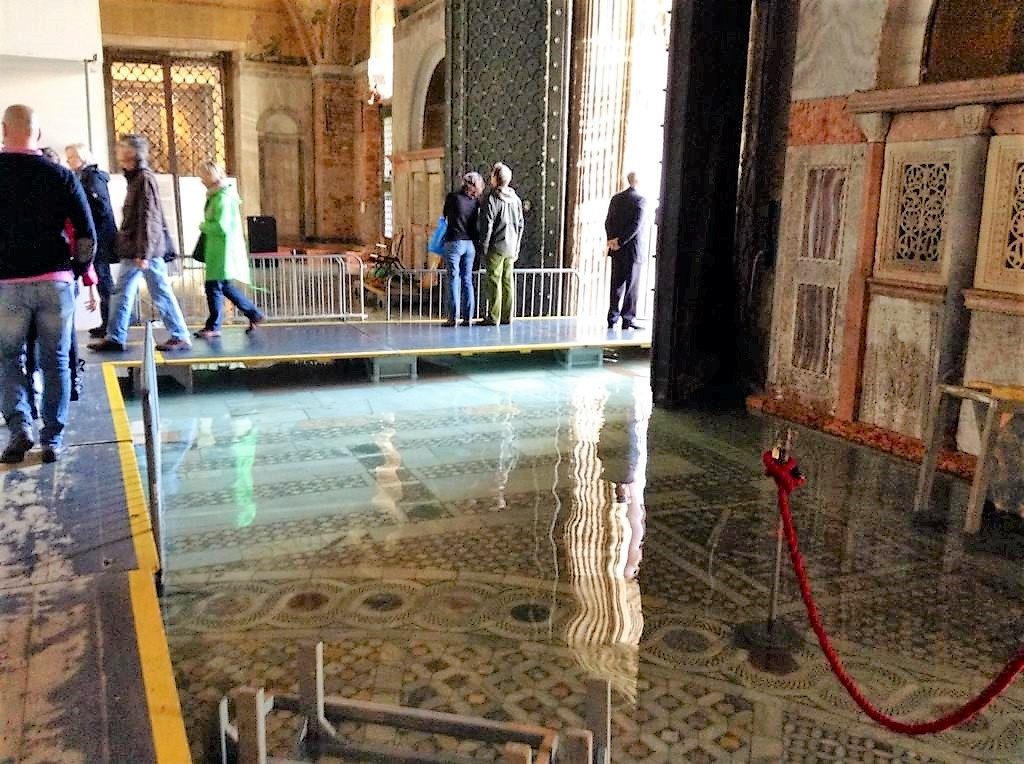
Platforms set up inside Saint Mark’s Basilica, whose foyer was flooded as well
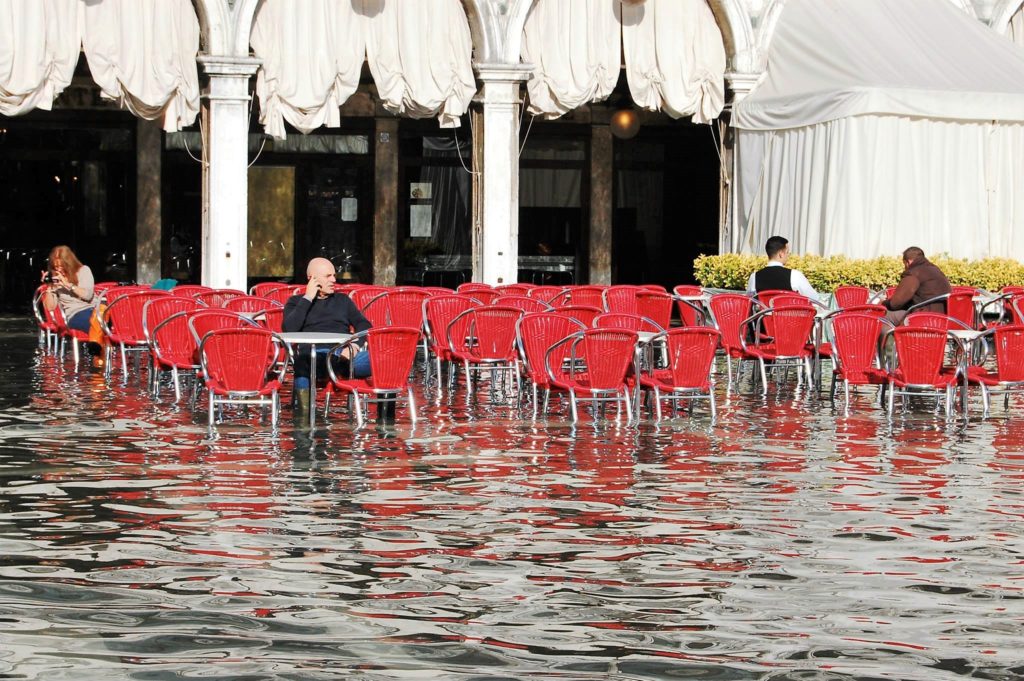
Venetians apparently ignoring the rising waters
By the time we ate lunch, the water had receded. My friend and I shed our boots and continued our exploration of the city. We were far more prepared the next morning when the sidewalks were flooded again!
Is Venice Sinking?
Most sources say yes, the city is slowly sinking. However, this is unrelated to its acqua alta floods. The land on which Venice is built is boggy, not solid, and therefore it is sinking under the weight of the buildings.
On the other hand, acqua alta flooding was first noted in 589 A.D. It has occurred every year since. If the flooding was evidence of sinking, surely the city would have sunk by now. Instead, the tidal floods are seasonal and cyclical, similar to those in the Bay of Fundy in Canada. An inconvenience to some, a unique experience to those with open minds looking for some fun, the acqua alta is not evidence of the sinking of Venice.
Next time you are planning a trip to Venice, go in November or December to experience the acqua alta phenomenon!
*Note, this page contains affiliate links. This means if you make a purchase after clicking on one of the links, I may receive commission at no extra cost to you. Thank you for contributing to the operating costs of this website!
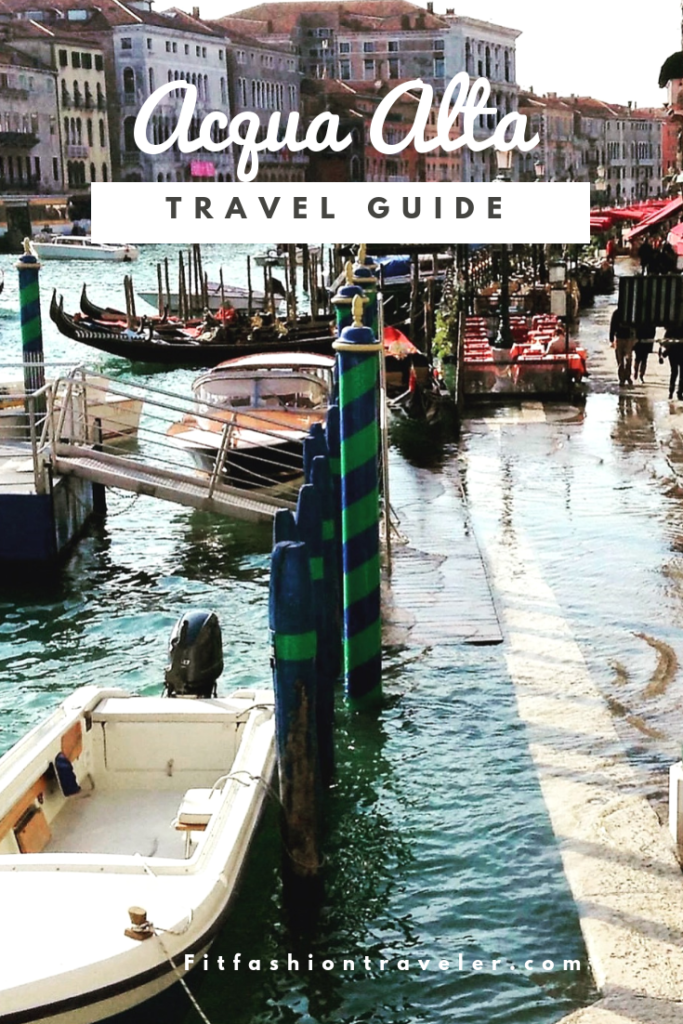

by Kelly | Feb 21, 2019 | Europe, France, Nice, Travel
I met French President Nicholas Sarkozy in Nice, France, in May 2010.
For the final weekend of my semester abroad, I took a short trip to the French Riviera. I had not planned on meeting President Sarkozy. I did not anticipate that my final European vacation that year would bring me face-to-face with the French president. My dad and I were unaware that we would be in the same city as Sarkozy. We did not have any intention of attempting to meet him. Nevertheless, as the city of Nice got ready to celebrate its 150th anniversary of uniting with France we found ourselves shaking hands with President Sarkozy himself.
Want to read about another one of my crazy adventures? Click here to learn about The Time I Tried to Go to Nicaragua!
A Weekend in the French Riviera
I studied abroad in Strasbourg, France, in the Spring of 2010. At the end of the term I had about a week of free time before flying back to the States. My dad flew over to France to help me carry back the extra items that I had picked up during my semester. Because of his help, he got to pick the destination of my final vacation. Though I had already been to the French Riviera twice that year, my dad really wanted to return to Nice, France, so we flew down for one last weekend.
Nice
The weekend began in downtown Nice. We rented bikes and rode along the shoreline on the Promenade des Anglais. It was a beautiful beach day, but the beaches in Nice are made of small rocks rather than sand! I tried to lay out in the sun, but it was too uncomfortable having just a towel between me and the rocks.
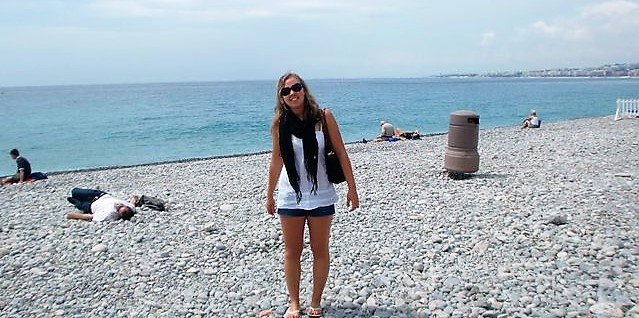
For dinner, my dad and I found the best outdoor restaurant area I've ever been to. Tucked away in the Old Town on Place Charles Félix were dozens of outdoor seating venues. Awnings, tables, and chairs available for patrons to sit at once they had selected their restaurant for the evening lined the pedestrian road. The menus all looked so good; we knew we wouldn't go wrong whichever place we picked. The fresh seafood from the Mediterranean Sea and produce from the fields of Provence did not disappoint.
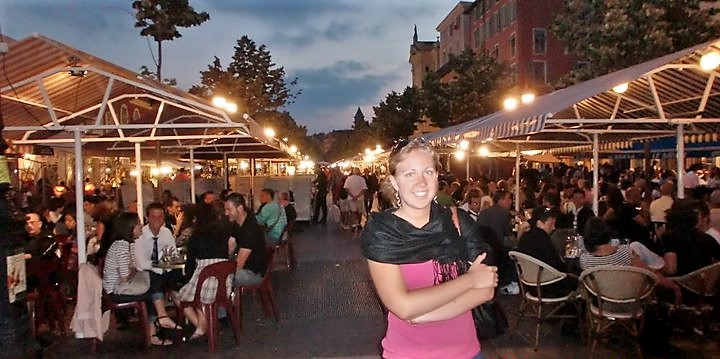
Cannes
During this trip to the French Riviera, I was determined to visit Nice's neighboring city Cannes for the first time. The train ride down the coast took less than an hour. We saw gorgeous views of the sea the entire way. Once in Cannes, the open air buses were a great way to see the city quickly. After my dad and I took our tour, we walked down a few side streets with stores offering everything from cheap souvenirs to luxury products, like tiny earrings for over 5,000 euros! We ended our excursion with a drink at a seaside resort lounge before taking the train back to Nice.
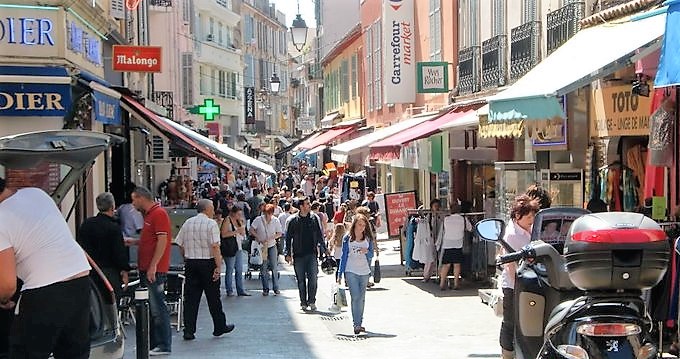
Typical side street in Cannes
Eze
In the opposite direction from Nice is the medieval city of Eze. Perched high on a hill overlooking the water, visitors can hike up to the castle and enjoy the views along the way, or take the less strenuous route to the top with public buses or taxis. My dad and I chose to hike up. Once we reached the fortress we meandered through the tiny streets that were home to the Romans, Moors, Greeks, Italians, and French over the past 4000 years (though the current fortress was built in 1388). There were many shops, restaurants, and hotels available for tourists mixed in with the houses residents still live in today.
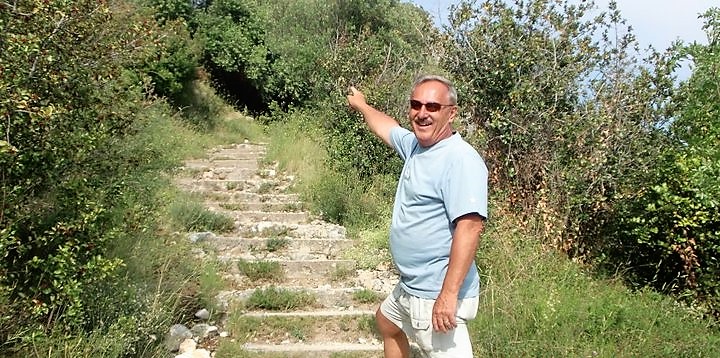
The hike up to Eze!

Views from a resting spot on the hike

Medieval City of Eze
Official Happenings in the City
All weekend my dad and I noticed an excitement that had not been present on previous trips to the French Riviera. Official-looking cars drove around town with the flags of various Francophone African nations sticking out from them. We also noticed a giant structure covered in a cloth and a giant French flag in the Parc Esplanade George Pompidou that was not there before.
A few inquiries to shop owners told us the official-looking cars held African leaders attending the 25th Africa-France Summit that weekend. As a scholar of international studies, I hoped to see some history in action or at least a famous African president after hearing this.
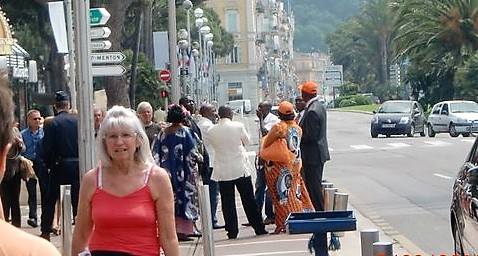
Gathering of official-looking African leaders on the Promenade des Anglais
The new structure covered in cloth was a monument constructed for the 150th anniversary of the unification of the country of Nice with the rest of France. It would be unveiled the following day. My dad and I made note of this, but had no affirmative plans to attend the unveiling ceremony.
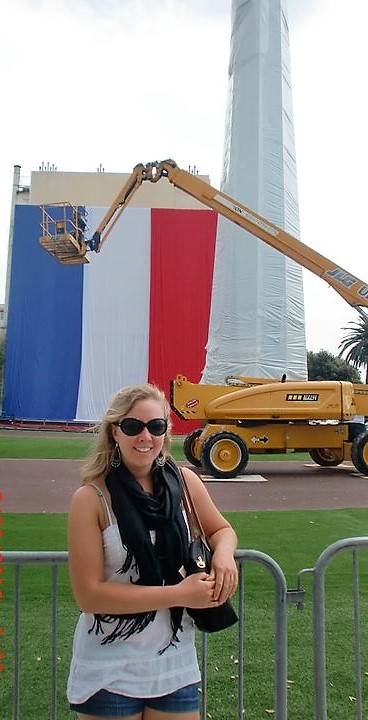
Covered structure
Meeting President Sarkozy
Little did I know we would be both meeting a famous president - though not an African one - and attending the unification celebration.
Preparing for the President's Arrival
Around 3:00 PM in the afternoon on May 31, 2010, my dad and I were walking along the Promenade des Anglais in search of some gelato. It was a beautiful day with many tourists in town, with all the shops and restaurants open for business. Or so we thought. As we walked, I realized that all the storefronts on the Promenade des Anglais were suddenly closing in the middle of this beautiful day.
We approached a gelato shop as the owner was wheeling his sidewalk freezer filed with ice cream inside. I asked him in French "what is going on?" and he urgently replied "Le Président!" Uncertain to what he meant, and suddenly questioning my ability to understand French, I asked "what do you mean the President?" to which he replied "Le Président vient!" ("The President is coming!"). Still confused, thinking maybe he meant one of the African presidents, I asked whether we could still get two cones of gelato.
Though the owner did not look pleased at our request, he served us two large cones of gelato. We took our ice cream cones and walked back down the Promenade. A large crowd had formed in the area by the Parc Esplanade George Pompidou.
Entering the Secure, Ticketed Area
Traffic on the promenade was halted and a large enclosed area set up on the road facing away from the Mediterranean Sea. Two policemen stood at the entrance to the area checking bags. As my dad and I approached, I handed my dad my gelato cone and opened my bag for the bag check. Seeing I had no restricted items, the police waved us through into the gated area.
We made our way up to the front of the crowd awaiting the arrival of some president. We could see the large covered structure in the park and the road in front of the structure from our vantage point in the second row. As I looked around to get a sense of what was going on and when it might begin, I noticed that everyone else around was very well dressed. Though it was a hot spring day, the women around us were wearing dresses and the men all had pants. In contrast, I had a tank top on over my bathing suit and my dad was in a t-shirt and shorts. We also were not holding the pamphlets or tickets everyone else had.
We clearly did not belong in that area. It was also clear that something important and exciting was happening, so we were not about to leave. In any event, the policemen had let us into the area despite our dress and lack of tickets. We waited in anticipation for whatever was going to happen next.

Media photo from Nice Cote Azur showing the crowds along the Promenade awaiting the ceremony
Arrival of French Ministers, including President Sarkozy
We waited a while before anything happened. After about 30 minutes of standing around an official-looking car drove down the Promenade des Anglais. It stopped right in front of us and a few French ministers got out, including then-Minister of Finance and current head of the International Monetary Fund Christine Lagarde! The officials walked towards the crowd right where we were standing. They shook hands and took pictures with the attendees in our area! I used my best French accent to say Bonjour to Christine Lagarde as I shook her hand, for fear of being found out and ejected before the event began.
A few more cars arrived with French officials who also greeted the crowds upon their arrivals. About fifteen minutes later, an even nicer car drove down the Promenade des Anglais with a large police escort around it. The crowd roared. The anticipation for the guest was high. The car stopped right in front of where I was standing, and out stepped President Nicholas Sarkozy!
As the other officials had done, President Sarkozy came over to the crowd in the gated area, walking directly towards my dad and me. I scrambled forward to shake his hand. Though he will never know my name, who I am, or even that I had been there, I was still very excited for my first meeting with a foreign leader. In my haste to get through the crowd to the front row I got some beautiful pictures of the trees in front of us instead of the President himself. I will never forget this memory.
Anniversary Celebration for Nice's Unification with France
When Sarkozy joined the celebration, the French national anthem played and the local children's choir sang. Local dance troupes performed traditional dances. A few prominent officials, including the Mayor of Nice, gave speeches. Finally, the cloth was removed from the giant structure to reveal nine giant rust-colored columns. Neuf Lignes Obliques or "nine leaning lines" symbolizes the nine valleys of the Country of Nice, which united with the rest of France in 1860.
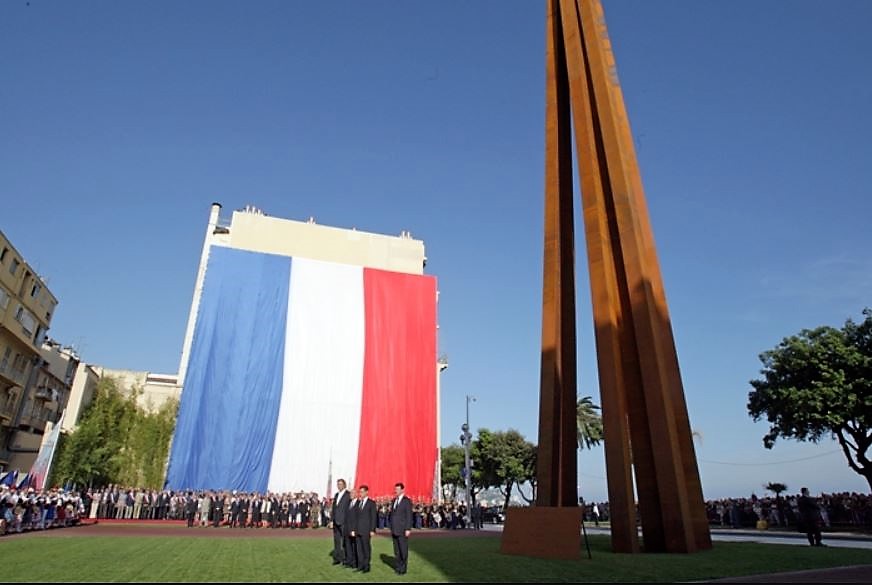
Media photo from Nice Cote Azur showing President Sarkozy, the Mayor of France, and other officials at the ceremony
The celebration was an interesting diversion during my third trip to Nice in as many months. Though I had wanted to experience a new country on my final trip in France, nothing could have topped being part of French history with Nice's celebration and my meeting President Sarkozy!
If you're planning a trip to Nice and wondering where to stay, I highly recommend the Hotel Suisse right on the water!
Love this post? Save it to Pinterest for later!
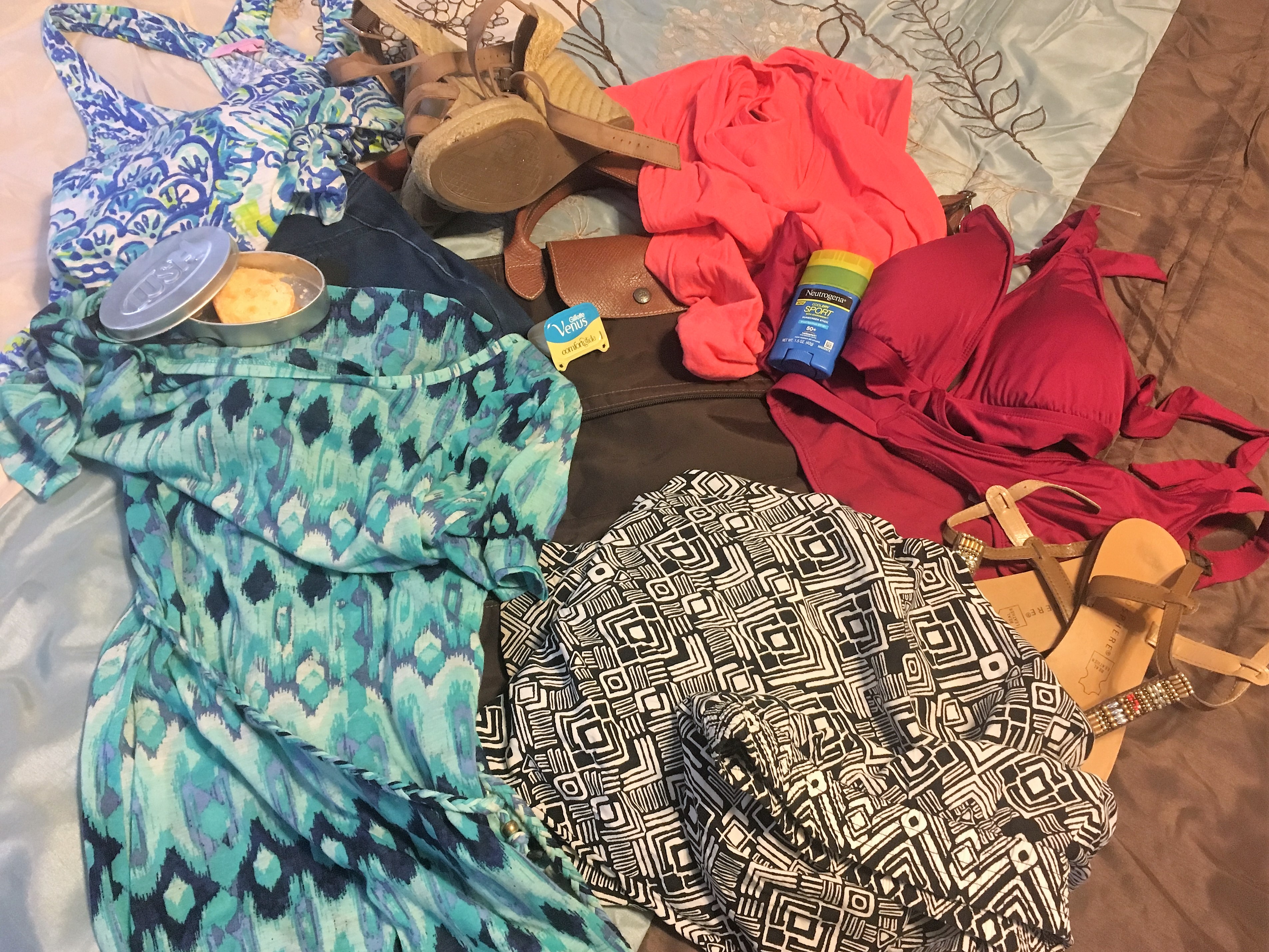
by Kelly | May 10, 2018 | Travel, Travel Advice
Anyone who has spent any amount of time talking world-travel with me has probably heard my #1 piece of advice: try to travel with just a carry-on. If you pack correctly and make a few adjustments to how you travel it’s really very easy.
When I lived in France as a college student, my friends and I traveled mostly on budget airlines Ryan Air and Easy Jet. Even now as a professional young adult I still am willing to use budget airlines to make my trips more affordable. Traveling on budget airlines means that you pay extra for everything, including extra weight in your carry-on over 15 lb, your checked back up to 30 lb, and and extra weight in your checked bag over 30 lb. For comparison’s sake, on regular non-budget U.S. flights there is usually no limit to the weight of your carry-on, and even if you are paying for your checked bag, it can weigh up to 50 lb.
Having traveled multiple times in Europe, the Caribbean, and Asia for 1-2 weeks using just a 10-15 lb carry-on, I know it is possible to pack everything you need in a small, lightweight bag to avoid extra fees. Here are my top 10 tips for packing just one carry-on for a long trip:
- When deciding which clothes to ditch while packing, leave the heaviest behind, you probably won’t miss them!
- You only need one pair of jeans and one set of pajamas for your entire trip.
- Pack as many non-liquid toiletries as possible: I love the solid shampoo and conditioner bars
 by Lush Cosmetics and Proactiv’s bar of face soap for exactly this purpose!
by Lush Cosmetics and Proactiv’s bar of face soap for exactly this purpose!
- I know the general travel knowledge is to roll clothes to pack them. Depending on the bag, I’ve always found I can fit more by packing clothes extremely flat with minimal folding, and sticking things like socks and underwear in the space formed by things like shoes and swimsuits.
- If you are bringing shoes with laces (like sneakers), tie them to the outside of your bag to not take up space inside.
- Wear your heaviest clothes and shoes on the plane.
- Wear or carry all your outerwear onto the plane (jackets, sweatshirts, scarves).
- Hold heavy books, iPads, etc casually in your arms as your bag is weighed at the airport if you need extra weight space. You can put these things back in later before going through security.
- Re-wear outfits if/when it makes sense: you’re never going to see the people you encounter on your travels again, and friends back home looking at your photos won’t notice or care about a repeat outfit.
- Plan to mail things back home if necessary, including heavier clothes and shoes if you are traveling from a cooler to a warmer climate, and souvenirs you don’t have to have with you on your journeys
Finally, I highly recommend investing in a good expandable carry-on so you can pack to go on your trip with it closed, then expand it for all your extra purchases and lazy-packing on your way back!
N.B. This post includes affiliate links. If you purchase an item through one of the links in this article, I receive compensation at no additional cost to you. As an Amazon Associate I earn from qualifying purchases.
Love this post? Save it to Pinterest for later!
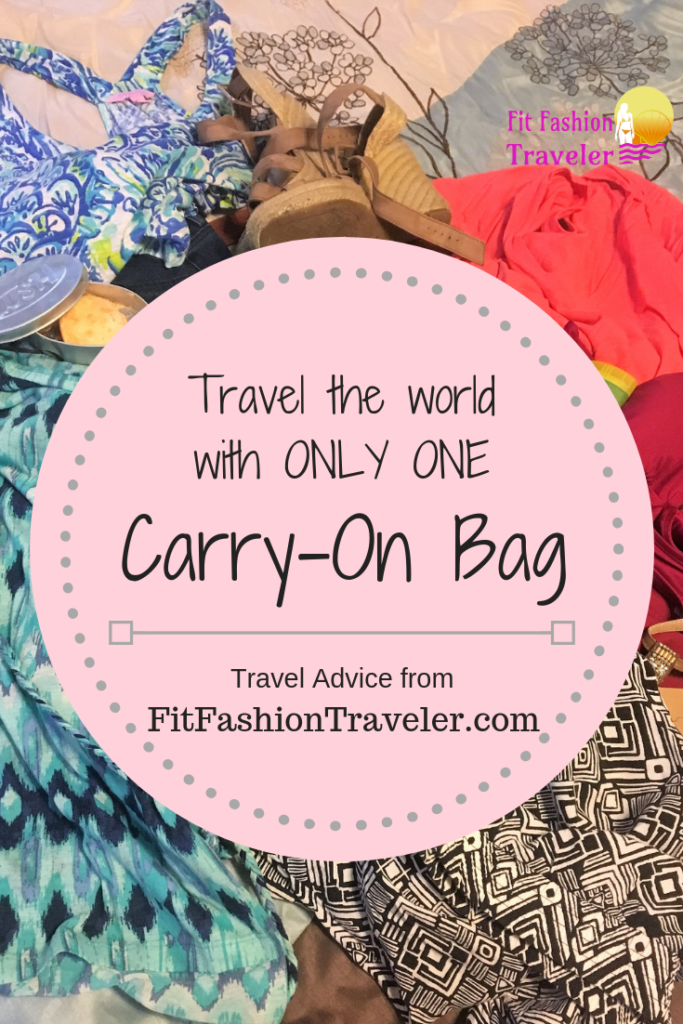

by Kelly | Sep 3, 2018 | Asia, Hanoi, Travel, Vietnam
Aside from wanting to visit every country in the world, Vietnam was never high on my travel priority list. I didn’t know much about the country and had heard great things about places like Thailand and Indonesia so I thought they would be my next Southeast Asian destinations. However, last year a friend who knows how much I love traveling was looking for someone to explore Vietnam with her. She implored me to look into the country before saying “no.” After doing some research, mainly on travel blogs like The Blonde Abroad and Nomadic Matt, I determined it was a great time to visit Vietnam! See below for recommendations from our first stop, the capital city Hanoi.
Favorite Tourist Attractions in Hanoi
Hanoi’s Old Quarter
We arrived late on a Saturday night in Hanoi after traveling for over 20 hours from Boston by way of Tokyo. Our hotel, Hanoi Imperial Hotel*, was located in the Old Quarter a few steps from Hoan Kiem Lake. Though it was very late, we were able to find dinner by the lake and explore the plaza. There were locals who were sitting around on plastic stools talking and listening to music. The atmosphere was very relaxed, which was exactly what we wanted after a long flight. We bought a couple of beers from the convenience store for less than $1 and wandered around the area. The lake was beautiful with the bright red bridge in the center. Though the temple was closed at night, we still explored its exterior architecture. We even encountered a man meditating on a rock pile, who had been so quiet and still when we first passed him we didn’t even notice he was there!
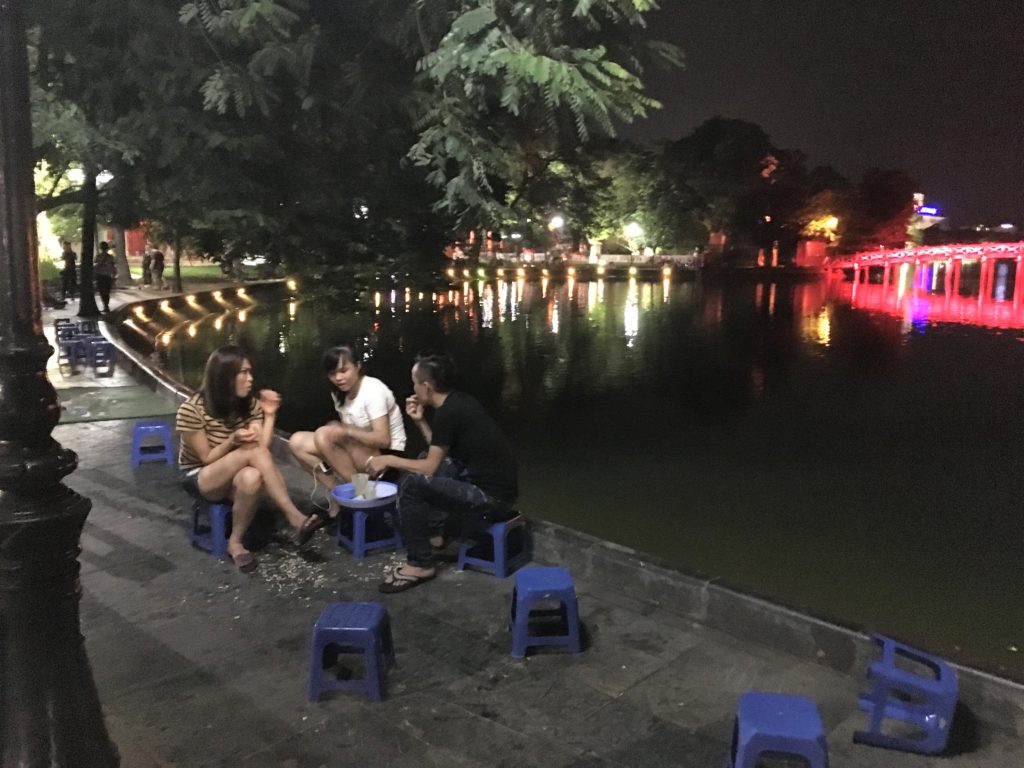
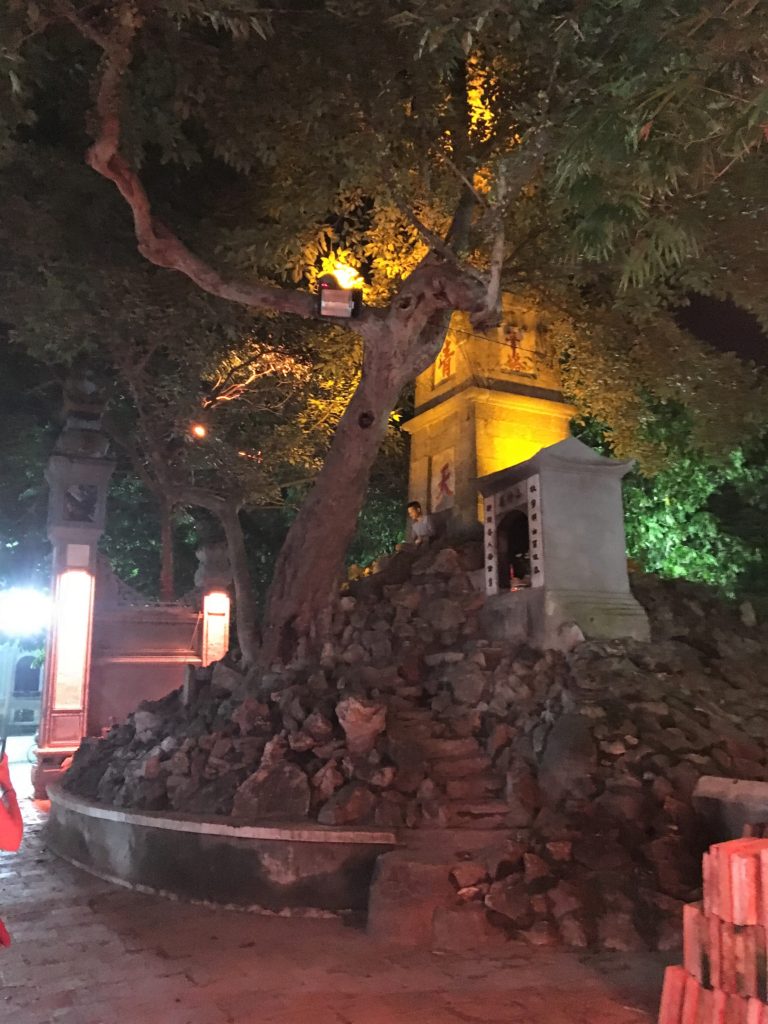
Man mediating by the tree on top of the rock monument
Tran Quoc Pagoda and Ho Chi Minh’s Mausoleum
The next two days were spent walking all over the city doing sightseeing. We traversed the streets in the heat up to West Lake, a bustling shopping and food area with the Tran Quoc Pagoda on a peninsula in the center. This was where we encountered our first cultural difference experience. While it was easily over 90 degrees Fahrenheit, no one was allowed onto the peninsula with bare shoulders or knees. My friend was reasonably wearing a tank top. This caused her to be barred from entry not only by the groundskeeper but even other locals! This happened again later at Ho Chi Minh’s Mausoleum, showing that the custom relates more to their perception of respect and reverence than religion.
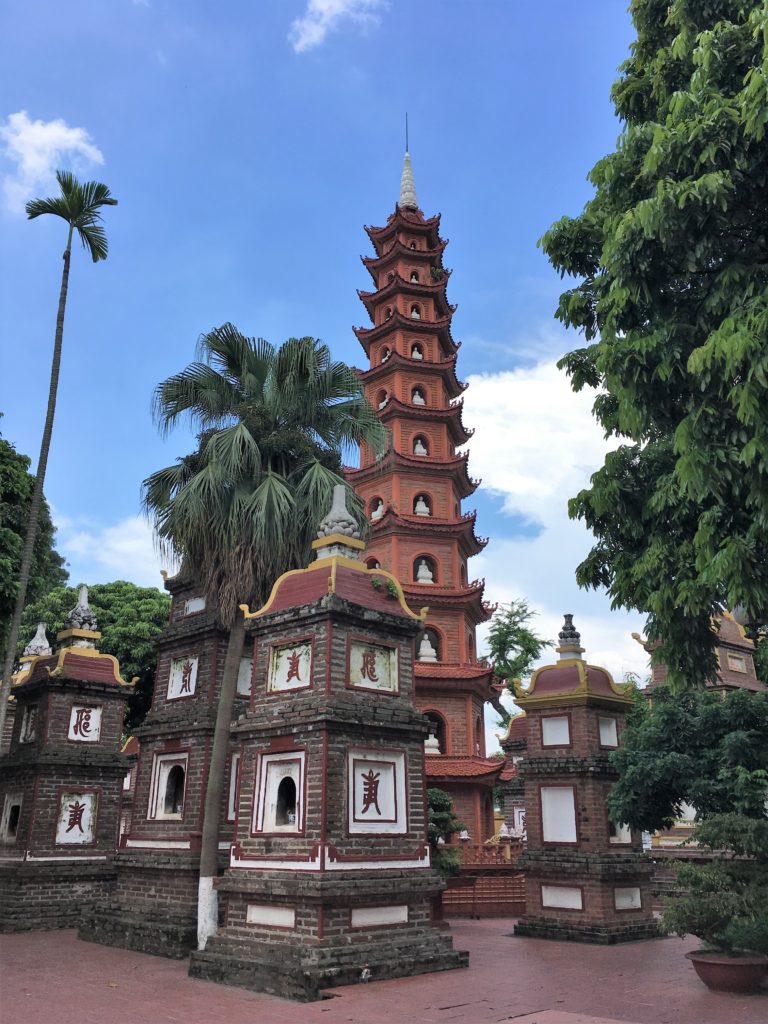
Inside the Tran Quoc Pagoda

Ho Chi Minh’s Mausoleum: we were not able to go inside as Ho Chi Minh was not even there! He was in Moscow at the time.
Perfume Pagoda and Temple of Literature
Both the Chinese and French influences were prevalent throughout the city. China is the regional hegemony and shares a border with Vietnam. It has controlled the Vietnamese land many times throughout history. This is apparent in the architecture, language, and religion in Vietnam. When visiting the Perfume Pagoda and the Temple of Literature, I felt like I was back in Beijing. The architecture is exactly the same as the Chinese Buddhist temples and the Confucian temple of learning. The concept of having a non-religious temple complex build for higher learning and education was also very Chinese.
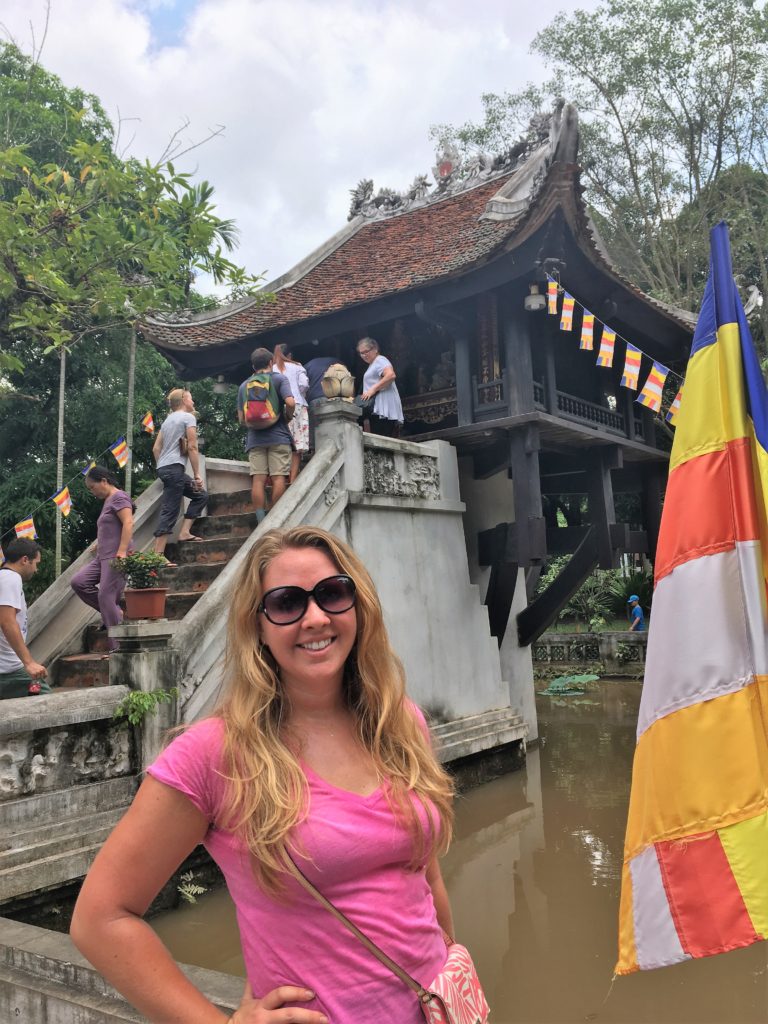
Perfume Pagoda
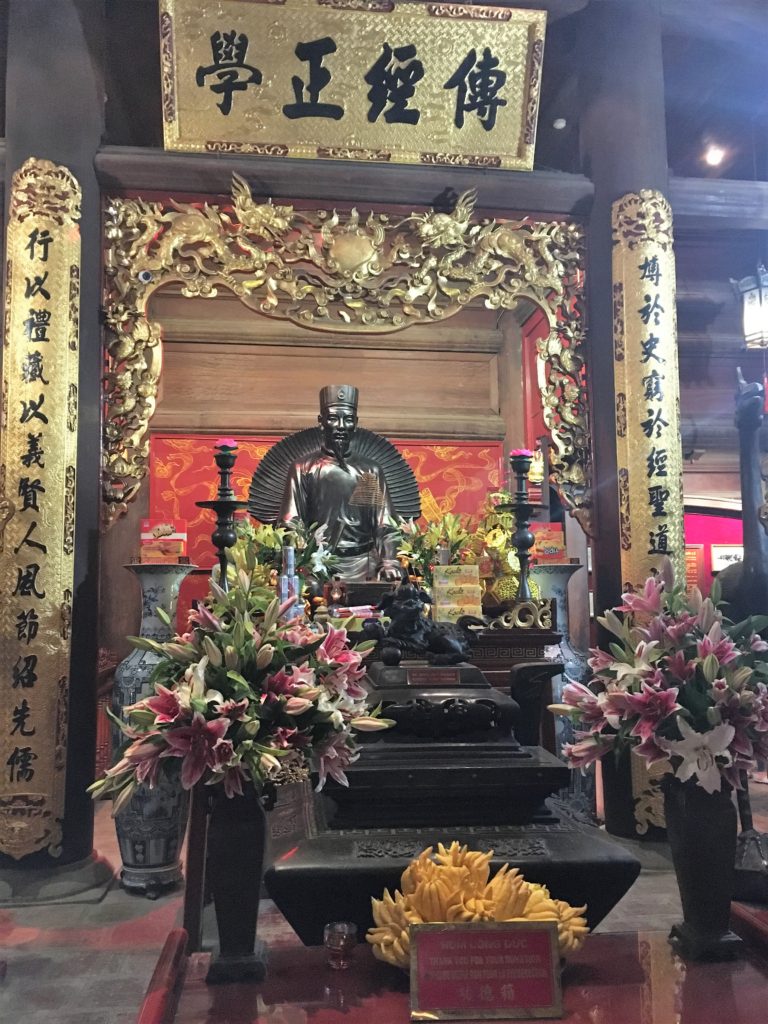
Inside the Temple of Literature you can see the Chinese influences and food offerings made by locals
The French influence was prevalent less in the tourist attractions and more in the buildings around the city. It was characterized by the bright mustard-colored paint and European designs. Most of the buildings are now Vietnamese government buildings, though there was one church that was clearly French-colonial too.
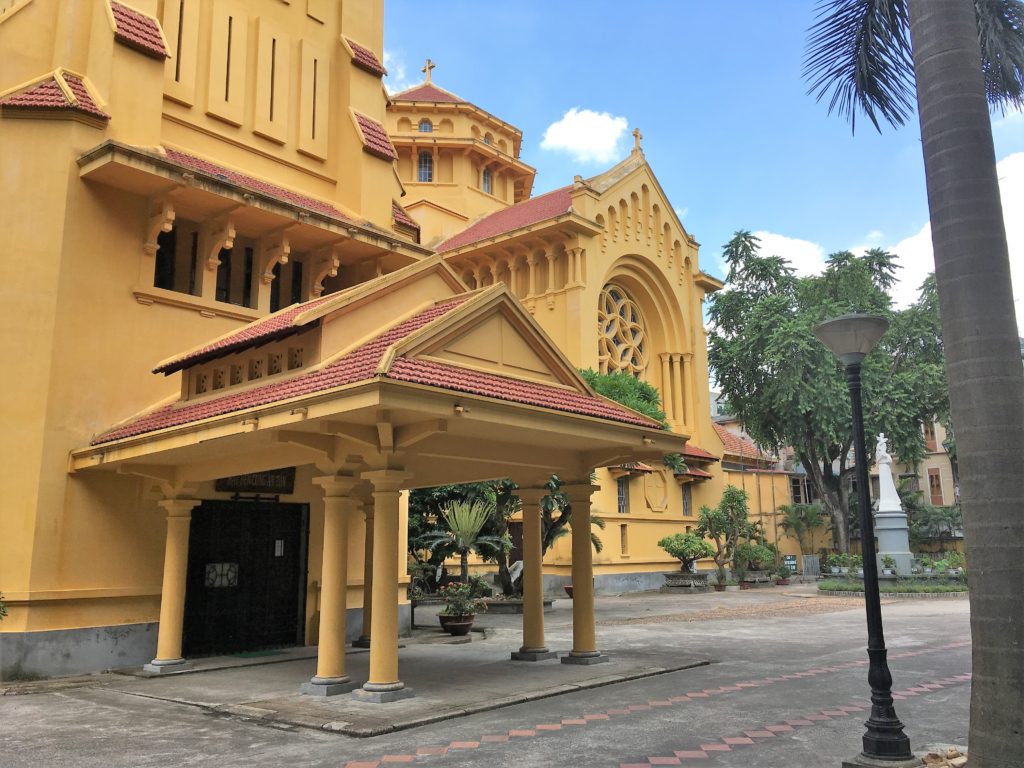
Hoa Lo Prison
The other French architecture remaining in the city was the Hoa Lo Prison. Built by French colonists in the late 1800s, the prison was originally used to house Vietnamese dissidents. When the Vietnamese threw out their colonists and were fighting Western powers during the Vietnam War, they used Hoa Lo Prison to house Prisoners of War (including John McCain). The experience visiting the prison was sobering but also fascinating and something I recommend to everyone who visits Hanoi.
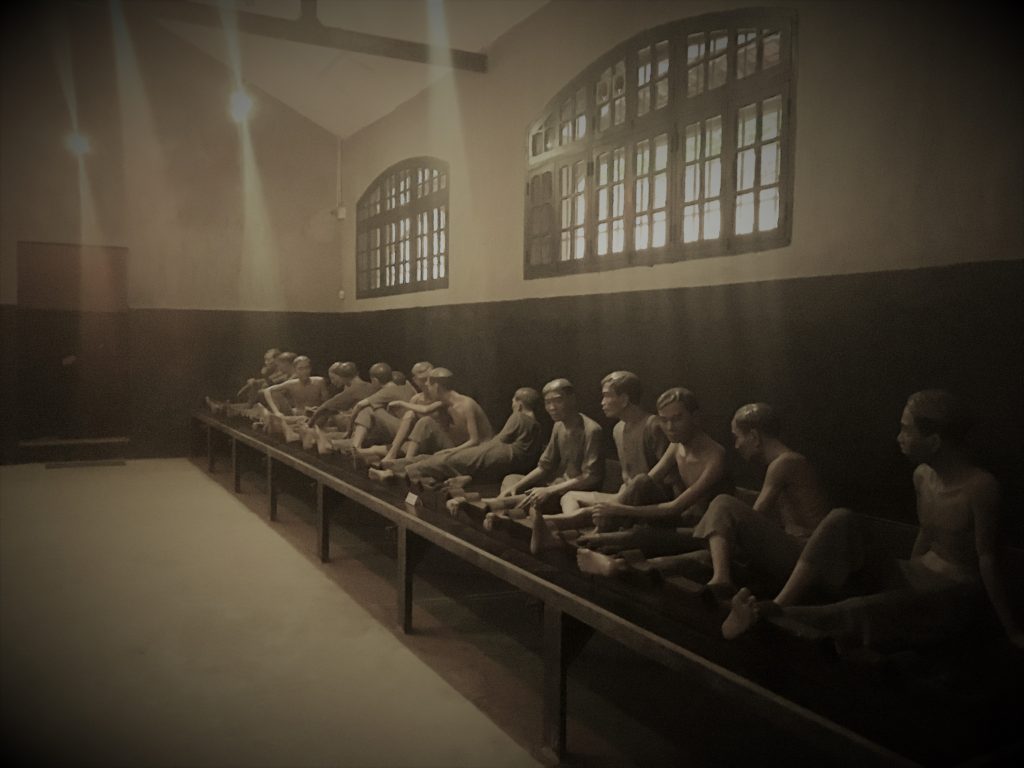
Thang Long Imperial Citadel
The Imperial Citadel also provides a sobering experience to Western visitors. Restored to its current state in the late 21st century, you can see influences from both Chinese and French architecture in the Citadel. The grounds are beautiful to explore and almost no area is barred to tourists. The complex has been used for government and military functions for centuries. This seems normal until you realize that includes Vietnamese military functions during the Vietnam War. Tourists can visit the room where generals planned attacks on Western forces and the bunker rooms where they hid when under attack. It is another can’t-miss attraction when you are in Hanoi.
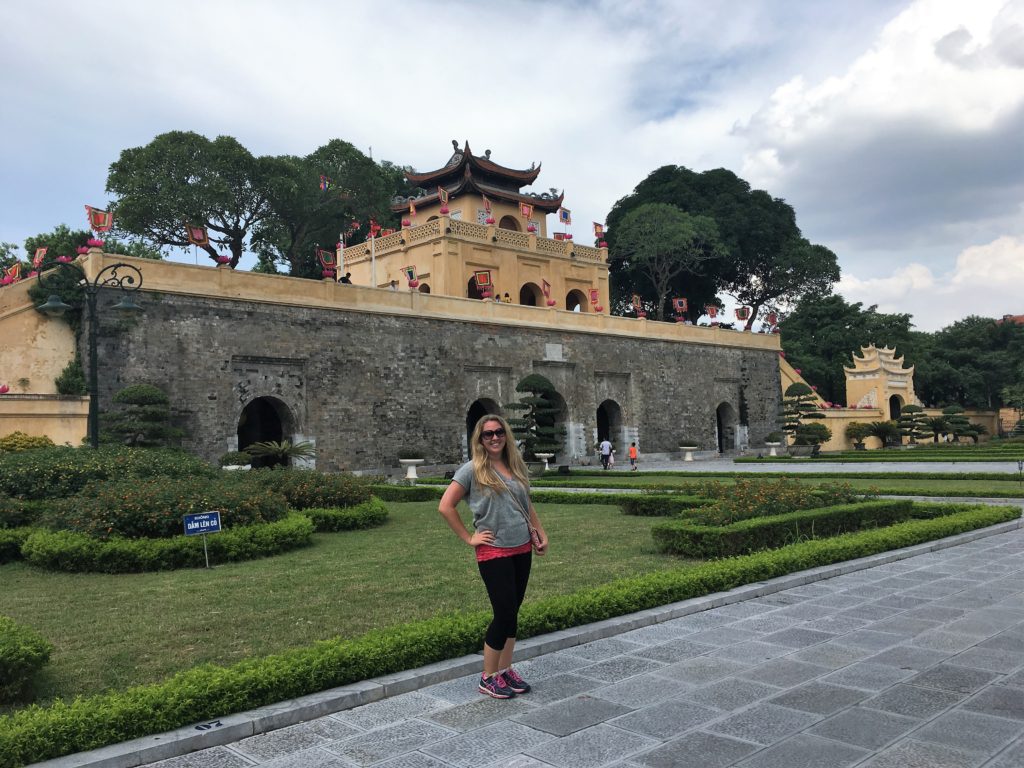
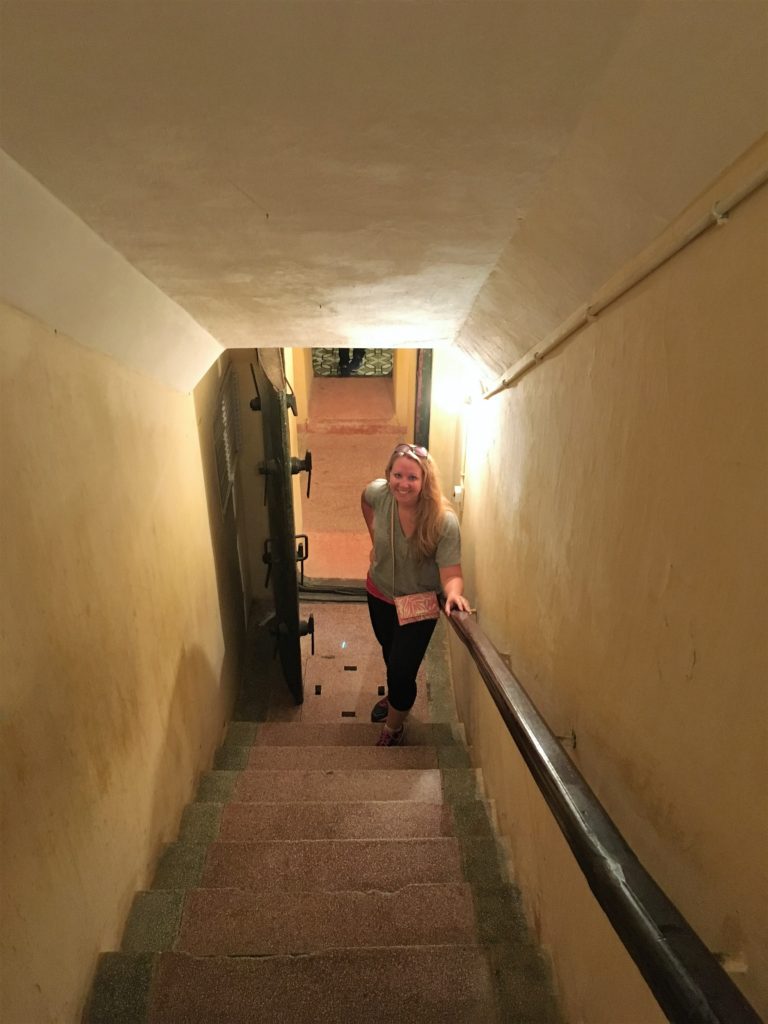
Down the stairs leading to the basement bunker
Nightlife
The nightlife in Hanoi is casual and unique in culture, like many other things in the city. If you prefer lounging in high-end clubs, Saigon will be more your speed in Vietnam. If you want to hang out with the locals and wander the streets from bar-to-bar in a vibrant, outdoor city at midnight, be sure to do so in Hanoi.
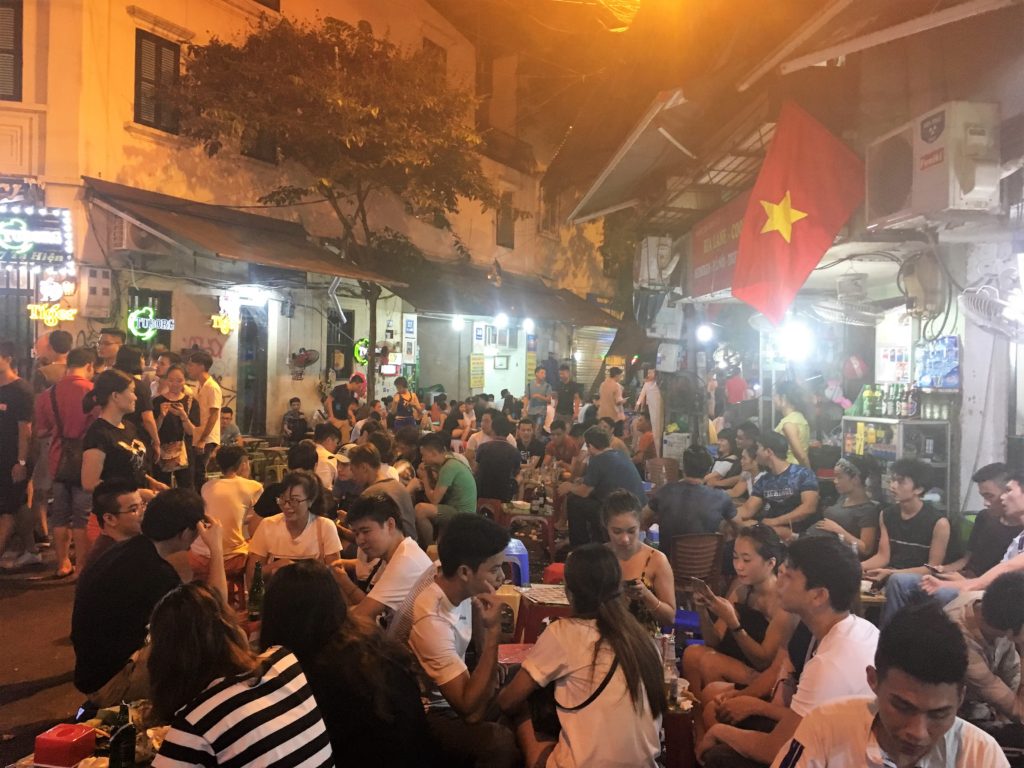

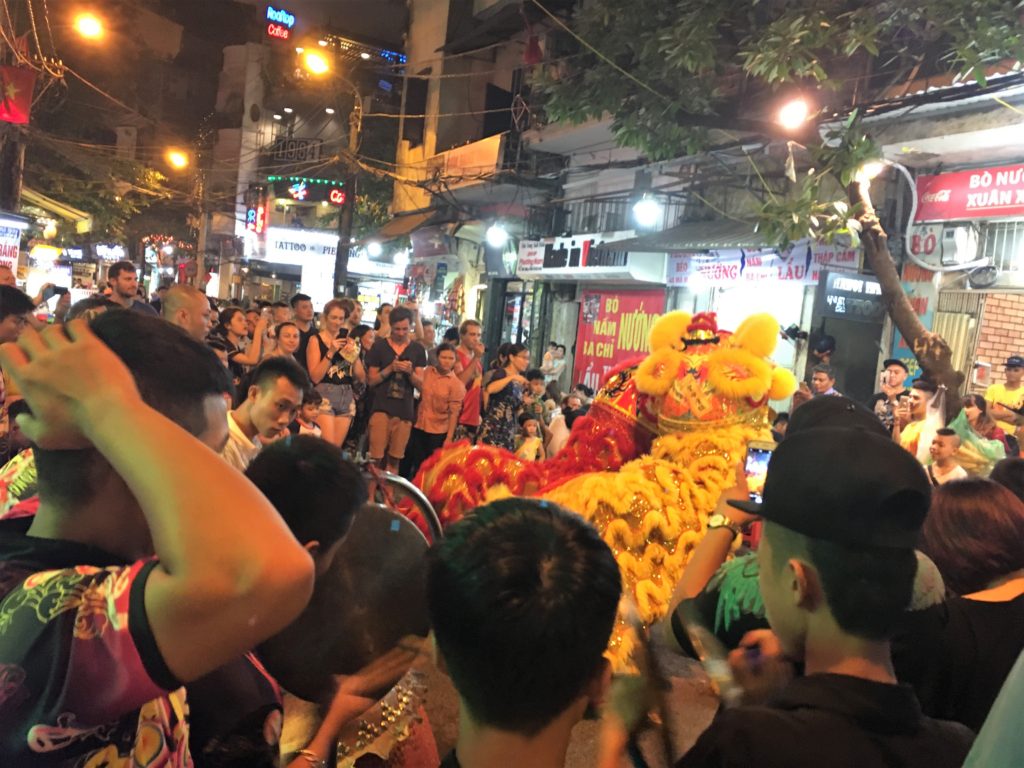
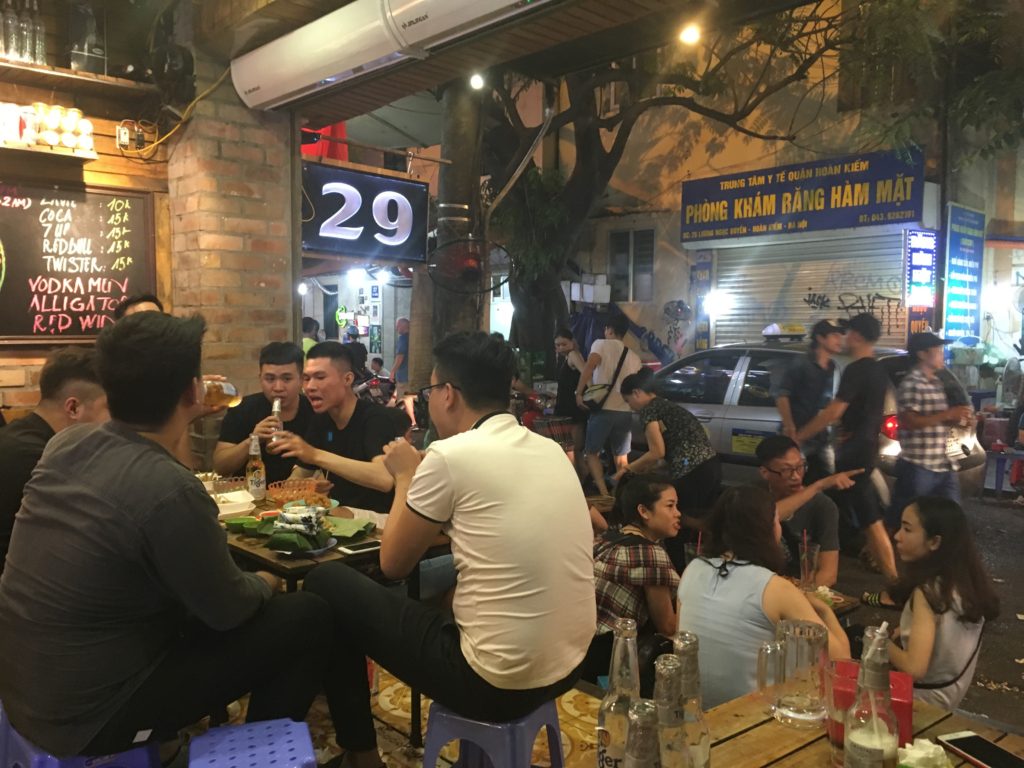
We were the only non-locals in this bar at the time! They all deterred us from ordering the street food they kept bringing in, probably for the best.
Vietnamese Culture in Hanoi
In Hanoi you can’t help but experience the culture firsthand, even as a tourist. There didn’t seem to be any way for my friend and me to insulate ourselves in a Western-culture bubble while in Hanoi, not that we wanted to!
Food
One of the most important parts of any culture is the food! We enjoyed meals at fancy-but-cheap restaurants and local hot spots with open air seating and plastic stools. Our favorite dishes were the spring rolls (both fried and fresh), beef pho, and Vietnamese barbeque.
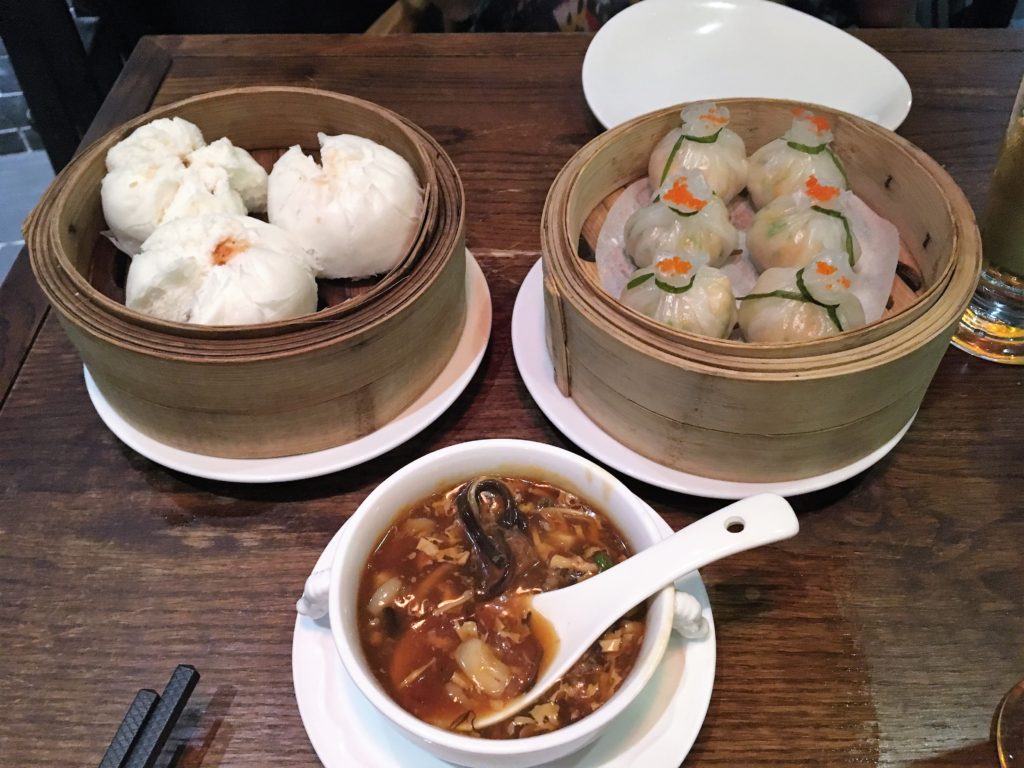
Dumplings and hot & sour soup at Fu Rong Hua
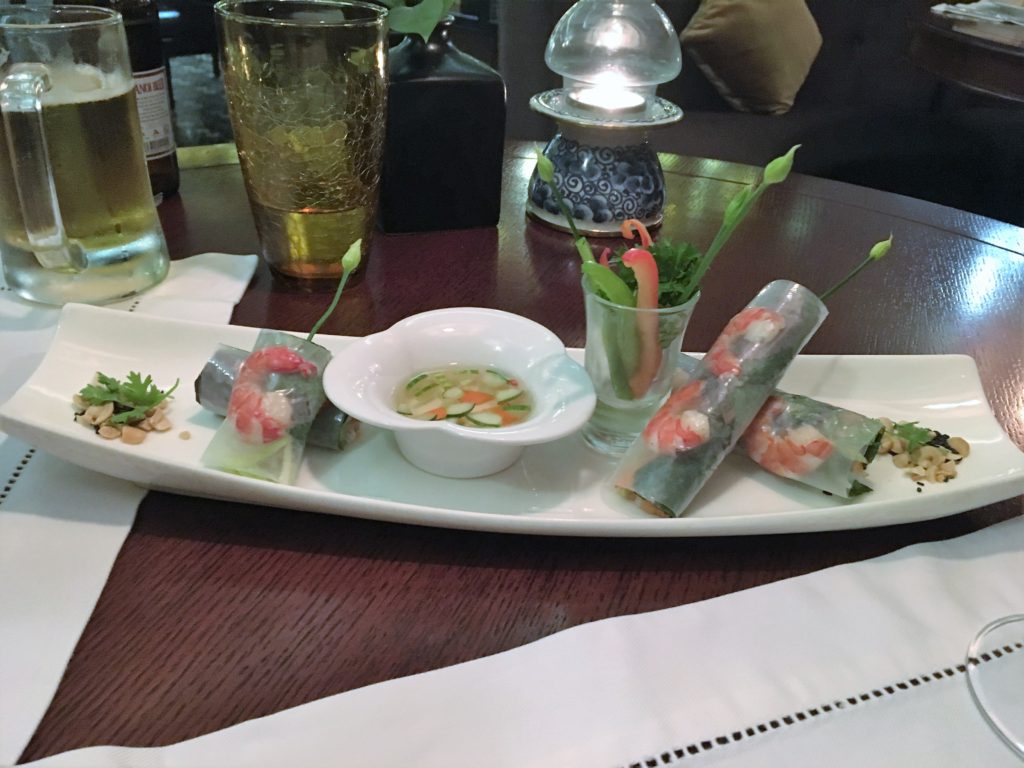
Fresh Spring Rolls
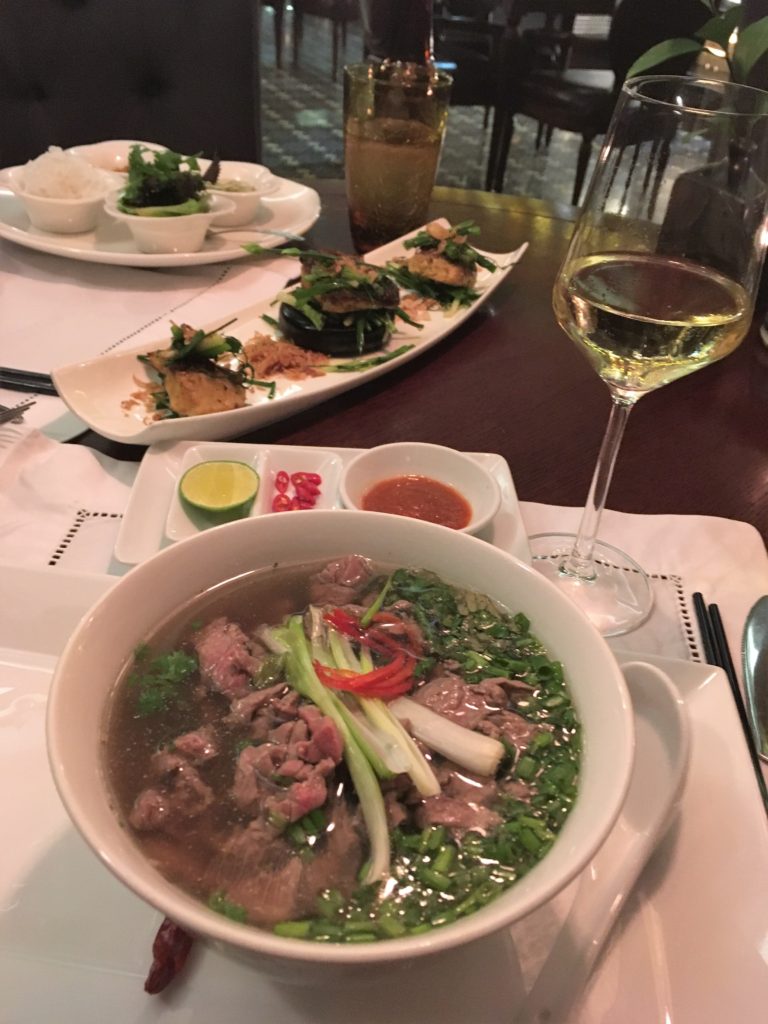
Beef Pho Soup, local fish, and local Vietnamese wine from the Dalat region
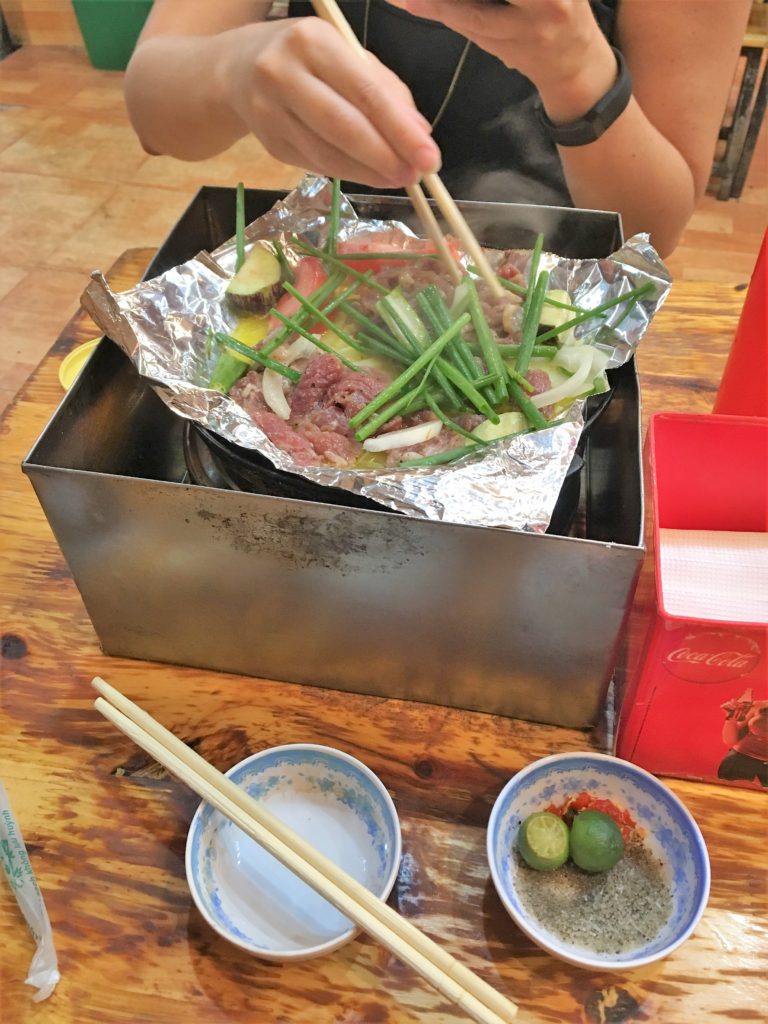
Barbeque on the street at Bo Nuong Xuan Xuan

Papaya shrimp salad, fresh and fried spring rolls, and soup at Ngon Villa
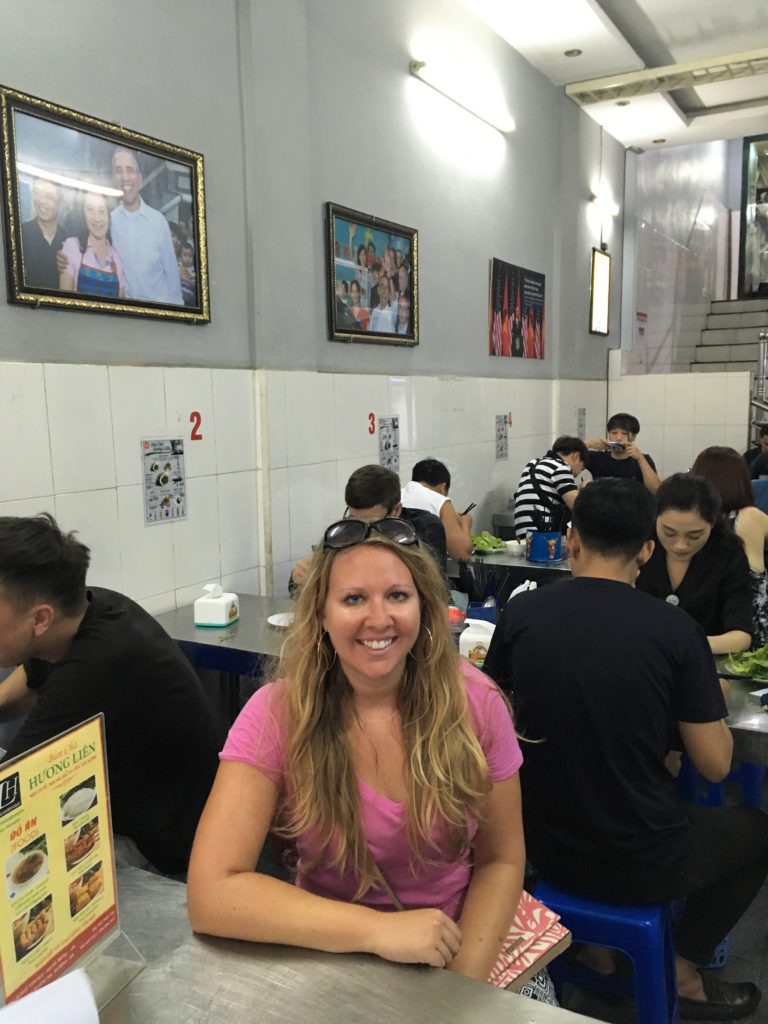
Eating Bun Cha at the same restaurant President Obama visited with Anthony Bourdain, Bún Chả Hương Liên!
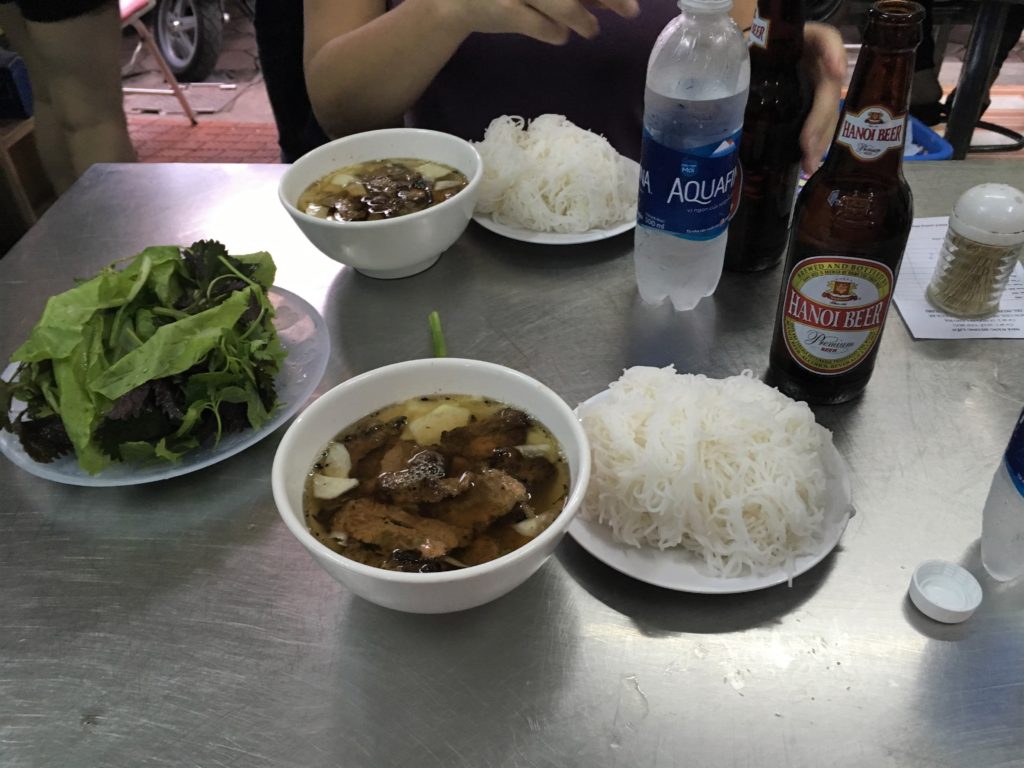
The “Obama Special” Bun Cha meal
Blind Massages
Because of the purchasing power parity in our favor, my friend and I knew that we wanted to get massages while in Vietnam. We had one at our hotel for $20 which was amazing. The next day we found a spa on a side road in the Old Quarter that we liked even more, the Midori Spa Hanoi. The services here were great and the massage was only $15. Best of all, the spa was also part of a social justice project. All the masseuses were blind! In Vietnam, where most jobs are service-related, sight-impaired citizens have trouble finding meaningful work. The Midori Spa hires blind people, trains them in massage therapy, and has them work like any other masseuse would. We loved being able to help such a great project and also relax while on vacation.
Shopping
Most people I encounter who visit Vietnam talk about the amazing bespoke clothing they have made for themselves. Unfortunately, my friend and I did not dedicate much time to shopping and therefore ran out of time to have self-designed clothes made. However, I purchased an original dress from a tailor tailor in the Old Quarter a couple of hours before we left for the airport. She even customized to my body by bringing in the waist and raising the hem. The shop had a number of dresses pre-made by the seamstress, and she also offered bespoke services, so if you are looking for specialty clothing I would search for bespoke tailors in Hanoi’s Old Quarter.
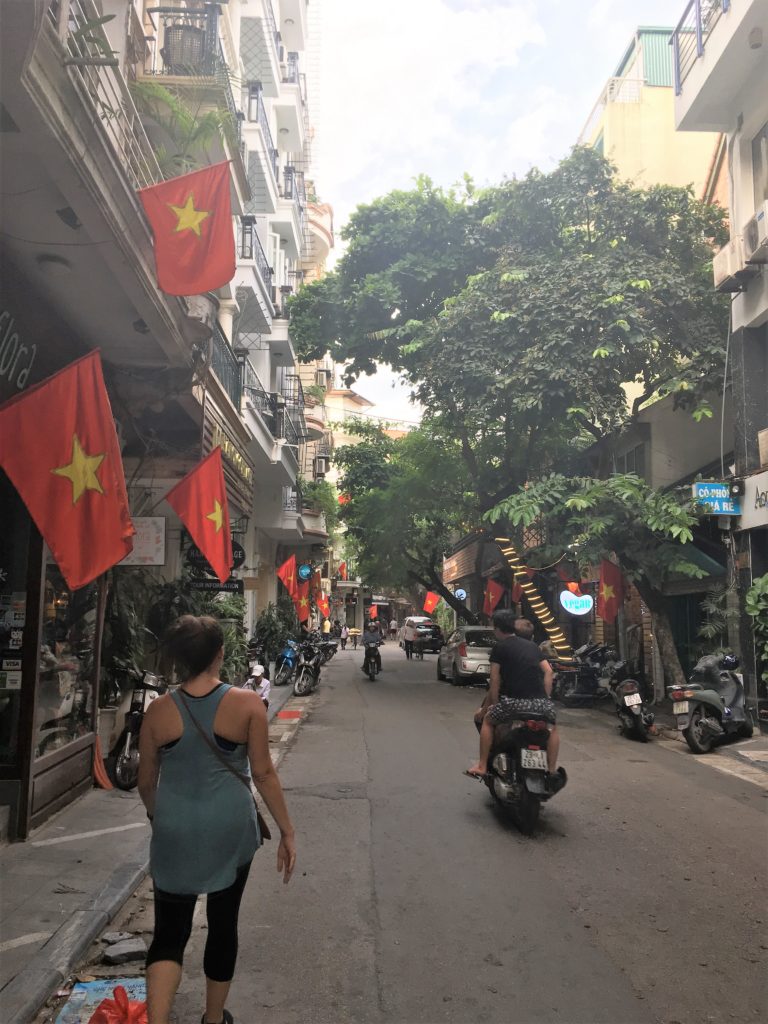
Cultural Differences
There were cultural differences in Hanoi that seemed odd to my friend and me, as there would be in any setting different from where you live. We arrived in Hanoi for the National Day weekend celebrations. During this time we saw an unusual Vietnamese custom tied to both the culture and religion: the burning of money as an offering to ancestors. We saw many piles of stuff burning in the middle of sidewalks and roads on the first day, so we thought everyone was burning their trash. We later learned that those were all offerings to ancestors. This seemed odd but acceptable until we saw one woman burning multiple $100 USD bills at the Perfume Pagoda. Perhaps she was wealthy, but she looked no richer than anyone else we had seen on the streets of Vietnam. It seemed completely irrational to us that someone would burn that much money as an offering, especially when we had not seen that much anywhere else in the city.
Another difference that I had expected but my friend had not was the “paparazzi” experience. There are very few white people who visit Vietnam, so seeing us was a rare experience for local people. I never felt unsafe because of my ethnicity or hair, but it did result in many people taking pictures of us or with us! The first time it happened, two women who did not speak English were holding their camera out to my friend at a tourist attraction, so she thought they wanted us to take a picture of them, but after some gesturing we learned that her companion wanted a photo with us. This happened a few more times throughout the trip, an experience we had fun participating in. However, there were also a number of people who randomly took photos of us as we passed them on the street and sat in restaurants. They were less than subtle about it, an unusual experience that made us understand better how celebrities must feel trying to live their everyday lives.
Overall, our visit to Hanoi was incredible in unexpected ways, and I would highly recommend it to anyone considering Southeast Asia! I know there are some negative reviews about Vietnam in a few travel blogs, but as long as you are ready to accept the cultural differences and recognize when something is part of their culture versus locals trying to take advantage of tourists, you will have an enjoyable trip.
*Note that this is an affiliate link, meaning that if you make a booking using this link I get some bonus at no additional cost to you. Still, I will only link to and recommend places I actually enjoy and want to recommend! Thank you!
Love this post? Save it to Pinterest for later!
